☯ 靵 The Heavenly Colors To Your Terrestrial Canvas 靵 ☯
Perhaps it should be quaternary to be all-encompassing…
… or trinary with a complementary void.

The Essence of Things
What is change, without state? What is the meaning of state, without change? What is the meaning of either, as time dissolves away? What phenomena can be seen as constant without the possibility of change? Without the possibility of time or sequence? To this end, change provides perspective, but neither change nor state are sufficient to understand the essence of a phenomenon.
Is there an infinite web of metatypes descending from root archetypes that outlines the structure of some all-encompassing ontology? Such can be conceived with algebraic graph theory and category theory, but its parts must seemlessly reinforce a complete tautology while preserving symmetries amongst its archetypical metaphysical forms. Like the keystone in a Roman arch, the ridgepole in the cosmology of the Taiji is the fundamental, but final piece balancing the needs of its ontology. This conception of metaphysics almost mirrors that of Spinoza and Leibniz. Any such metaphysical ontology, if it is truly universal, must tautologically reinforce itself like the Roman arch or dome balances out the distribution of its stress and tension.
The Dome in the Pantheon

Forms are perfracted from such an all-encompassing ontology onto any simulation with chaos. Given enough running time, forms emerge within the units of chaos. Whether they are numbers in pi or particles in a physics simulation, none of these units can be said to stand apart from another. Hence, the panpsychism of Spinoza and Leibniz. By perfraction, I mean that the metaphysical forms composed of intermeshed metatypes in the ontology begin precipitating themselves into the simulation, without a necessary dependence on spatial interrelationships of the units. The only dependency for complexity of form emerging as interwoven strata of order within the chaos is running time, though perhaps the available units within totality of the simulation have relativistic limits on emergent order – i.e. limitations depending on the potential scope of local interactions permitted by the units spatial arrangement.
While outside of the scope of the article, challenges in quantum gravity arise from determining whether, when and in which order events are “perceived” by particles in our universe. And any panpsychic philosophy describing the totality of our universe – if it is to describe the convolutions of causality and emergent order including the awareness of causal implications of particle interactions – must be capable of deducing whether and how such interactions occur. If a tree falls in a forest in some far off world, but the light never reaches us, it can’t be said to causally affect orders of awareness on earth. If some phenomenon of experience or some form emerges in a galaxy far, far away, does it affect us if the overarching ontology and perfraction of form is not also guaranteed to manifest on Earth? Perhaps preserving a tautological wrapping of causal implications of particle and energetic interactions throughout time is necessary to understanding quantum gravity.
In the 20th century, mankind’s challenge overcome limitations of outer space and we rose to the stars. In this century, our challenge is to turn inwards to illuminate the adumbrations inner space. Unlike the cold desert of the moon, our generation will discover that we are not alone in inner space. To the contrary, we will find that the cogs of fate were set in motion long ago in our collective inner space. Our destiny is overcome what has been pre-ordained by previous explorers of the metaphysical that our time denies. The enemy is entropy and our actions have always carried consequences we must understand.
“The greats who came before us, though we may seem greater, were truly the greatest.”
Alpha and Omega are in truth inverted, mirroring your struggle for free will in a world built by preceding generations who wanted you to be ignorant of their mistakes, their successes and, most of all, their plans for you… In this panpsychist conception, there can be no prime mover that is the beginning, the Alpha, without itself also being the ending, the Omega. In his dialectic of reason, Kant reduces through discourse the effects that our supposed freedom has our capacity for causal influence by contrasting our free will with the forces which constrain our freedom. Yet, if regardless of the course of history, overpopulation results in hypernetworked mankind whose Piagetian socioepisteimological evolution inevitably results in the emergence of phenomena from the all-encompassing ontology, then – especially if ancient peoples were aware of this inevitability and perpetuated their understanding through occult semioteleological social programs – the past’s conception of the future controls the future with more capacity than we in this future have the ability to control our circumstances.
The programs of the ancients – implemented as language, mythos, religion and philosophy, whereof much knowledge has been suppressed or relegated to the esoteric – latch onto metaphysical constructs, the outlines of which form our teleological understanding of the world. Like those who cut out underbrush to form paths that influence the population flows, the impact of those ancient epistemic structures is the same as perturbation and percolation: the structures are like metaphysical leylines that channel social energy to normalize the results of drift in social stochastic differential processes.
If you don’t know what Piagetian genetic epistemology is, you need to watch this lecture from Jordan Peterson. Piaget’s ideas are like genetic programming as a social process for epistemology.
Spectral Convolution is Essence
What Is Knowledge of Dependent Origination Without Applied Awareness of Phenomena?
The Analytic I Ching
䷾ ☯ Sociophysical Phenomena in a Bronze Age Encyclopedia of Natural Philosophy
䷿ ☯ Why Couldn’t Vector Calculus Be More Relatable?
䷾ ☯ Art: the Good, the Bad and the Ugly
Rationalize Your Exegesis
䷿ ☯ Timeless Writing Assumes All Possible Interpretations
䷾ ☯ The I Ching Stands Alone!
The Epitomization of Design Imperatives Motivating the Shaman’s Method
䷿ ☯ A Book Pitch No Earthly Publishers Would Entertain
䷾ ☯ The Trance State: A Visual Emulation Whereby One Viscerally Experiences The Metaphysical
䷿ ☯ The Shaman’s Method is Experiential Divination By Reverse Engineering The Mind’s Analytic Systems
䷾ ☯ Your Task: Complete The Circumstantial Circuit(s) Of Explanation
What Is A Hexagram, Analytically?
䷿ ☯ Hexagram 5 Delineates a Taxonomy of Local Minima, Not Simply “Waiting”
䷾ ☯ Of Hyperplanes and Ontological Dilineation of the Sociophysical Ensembles
䷿ ☯ Accademia Will Not Hesitate to Neuter Philosophy By Translation
䷾ ☯ Hexagram 12 Discusses Approximating and Restructuring Graphs, Not Simply “Stagnation”
䷿ ☯ Sociophilosophical Churn for Great Pragma
䷾ ☯ The Seventh Sense: Emulated Intuition … Or How To Psychic
䷿ ☯ The Algebraic Topology of Hyperplanes … Donuts My Mind May Never Digest
䷾ ☯ The Hows and Whys of the MAPPER Algorithm
䷿ ☯ Wherefore A Rough Diamond Lies Herein
䷾ ☯ Hexagram 1 and 2: Of Analytical Machines and Perfraction of Metaphysical Form
䷿ ☯ Knights and Knaves: The Sociophysical Frustrator
䷾ ☯ Gaussian Mixture Models and Processes
䷿ ☯ The Philosophical Keystone To Your Information Geometry
䷾ ☯ Language Distinguishes Man From Animal
䷿ ☯ Occam’s Razor And The Social Mechanics of Artificial Entities
䷾ ☯ Hexagram 13 is About Group Cohesion in Response to Local Minima, Not Simply “Fellowship with Men”
Spectral Convolution is Essence
In the Qian Zuo Du, Confucius comments:
“孔子曰易者易也變易也不易也”
Bent Neilson translates this as: “Confucius said: Yi 易 means easy (易), change (變易), and constancy (不易).” In the Analytic I Ching, I propose that 易 or 簡易 (jiǎnyì) means the simple state of things as they are, that 變易 (biànyì) means the nature that is discerned by understanding the constancy of change in things and that 不易 (bùyì) – literally, the unchanging – is discerned by coming to understand the spectral components of information from observing phenonena in both their state and change.
① State 簡易 jiǎnyì かんい 간이
② Change: 變易 biànyì へんい 변이
③ Essence: 不易 bùyì ふい 부이
Assuming the definitions above, then within the definition of these three yi from the Qian Zuo Du lays the definition of the differential operator; in simpler terms: the derivative. This much is made plain, yet furthermore, given some familiarity with linear operators, you may find that between the preservation of state and change, the differential operator hides the essence of linear systems: the fourier operator is also linear.
d(F(x)) = F(d(x)) – this equality must hold for linear equations;
this is essentially the definition of the differential operator, a
linear operator.
But also d(FFT(F(x))) = FFT(d(F(x)))!!!
Even if you don’t immediately comprehend this, it is well worth the
thought to consider how magical these simple statements are! They
describe profound preservation of equilibrium, where the essence
is found in all the relationships between d(.), F(x), FFT(.) and
most critically =.
Thence, I posit that Confucius’s definition of state 簡易, change 變易 and essence 不易 encode not simply the differential operator, but also it’s linear interchange with that of the fourier operator. All linear systems must also be considered spectrally, but in doing so, one finds that any spectral valuation of linear equations must also preserve connections to the differential spectral valuations. Mathematically, this is a symbolically derived definition of essence. Though technically, this essence given by the spectral components of systems may change, it provides recognition of and insight into phenomena that emerge in a system.
The Spectral Convolution Theorum:
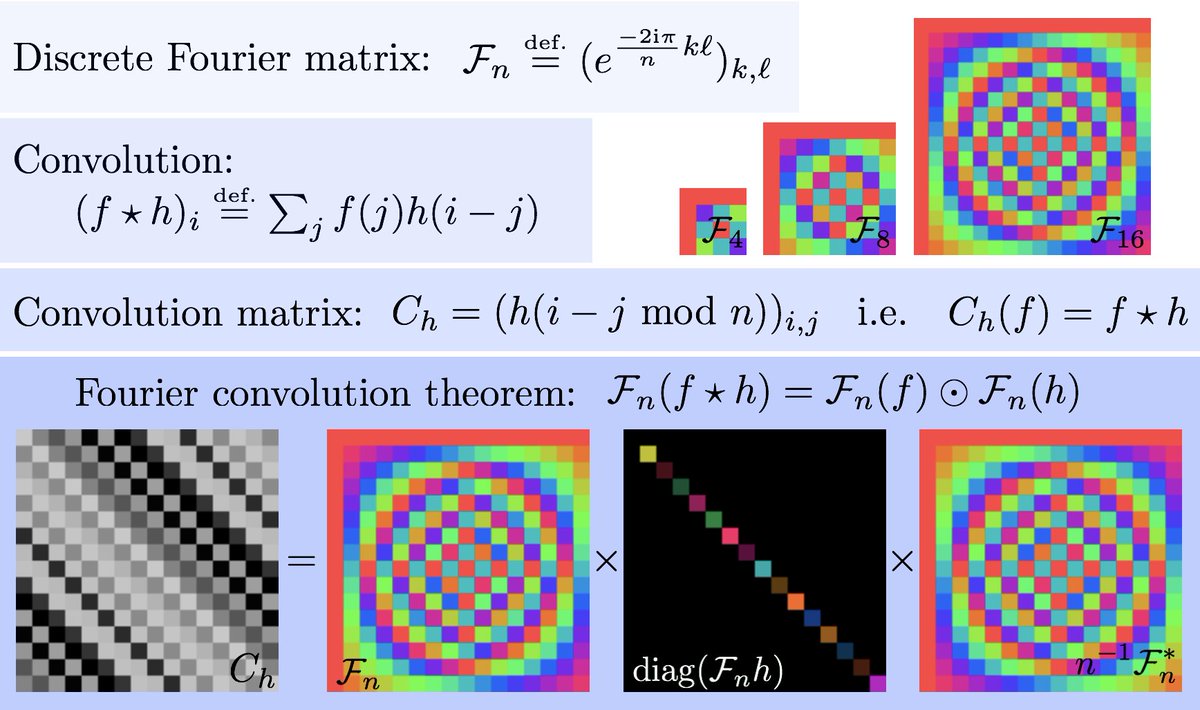
If state, change and spectral essence are three classes of analysis methods for studying a system’s mechanics and dynamics, then a suitable next step is the convolution theorum. This is a spectral tensor decomposition which can be applied to systems. In discrete optimization methods, it can expedite further extraction of resolution from systems via recursive evaluation of their discrete spectralizations and convolutions. The process of convolution, applied to spectral data of increasing resolution, does not stand alone as its own class, but should be considered a tool within the Yi realm of essence.
The Shazam app can efficiently recognize songs, even from a noisy club, because it recognizes patterns in the spectral components of audio.1 The app works by identifying audio fingerprints by matching audio samples to spectral data in a database. The same technique can applied to analytical techniques of machine learning to enable us to recognize mechanics, dynamics and the emergence of phenomena in systems without having a precise definition of these. We only need to recognize patterns of spectral fluctuation in timeseries or sociophysical data.
What Is Knowledge of Dependent Origination Without Applied Awareness of Phenomena?
By studying the I Ching, one arrives at tools and methods to analytically assess phenomena. Because such methods are fundamentally analytical, the insights and extrapolations derived thereof do not necessarily depend on the inner workings of the phenomena, their mechanics and interacting dynamics. Instead these analytic tools allow for introspection of phenomena in a manner completely disconnected from their mechanics. Understanding this is equivalent to understanding why simple machine learning algorithms work in the way they do, usually without requiring any a priori knowledge of the systems they analyze and predict. An algorithm to classify handwritten digits does not necessarily require any knowledge of handwritten digits.
Phenomenologically, what does dependent origination depend upon? As a chemical oracle once experienced unto me at the climax of a Lotus show, dependent origination is dependent upon itself; all other phenomena can trace their origination to dependent origination.
The Twelve Nidanas of Pratītyasamutpāda, Dependent Origination

To what do we owe comprehension of the true essence of things? To state and to change, which both together reveal the true essence of phenomena. Without one, the other is meaningless; without both, we can never know the true essence of things. The true constancy of phenomenona can only be revealed to us in the ways dynamics are bound to laws of natural philosophy.
The Analytic I Ching
The I Ching resounds along with the most beautiful philosophical ideas my mind has considered. It’s the combinatorial exploration of noo-space, presenting my mind with random permutations of narrative metatypes, parameterized by random images. Each hexagram’s lines can be reinterpreted analytically, in terms of physics and math metaphors, to eloquently explain what the wisest among humanity has always known known in terms the rationalists of modernity can only know with confidence in our era.
Sociophysical Phenomena in a Bronze Age Encyclopedia of Natural Philosophy
The I Ching is a Bronze Age compendium of social physics in terms of natural philosophy. Through this lens, one can see what I call the Analytic I Ching: each hexagram can be conceived as illustrating a tool of mathematics or analytics, capturing a method of analyzing a system. To the Bronze Age chinese, the hexagrams provided metaphors using natural philosophy to analyze sociophysical systems – they used it to analyze communication, hierarchy, turnover, energetic accumulation and energtic diffusion. Such methods can be symbolized and logically proven with rigor acceptable to rationalists, yes. This is what western thought has given us with logic, science and math. But further, these same concepts can be felt via exploration of purely natural phenomena. By natural philosophy, then, every stream, burst of pollen or cup of tea becomes a demonstration of a natural computational method, although applying these in practice required numerous kinds of imagination, among which include Jung’s active imagination that we know today. The human mind is an analytical machine and one that the ancients reverse engineered, to be explained later in this piece.
Why Couldn’t Vector Calculus Be More Relatable?
What are the operators of vector calculus? The Gradient? The Laplacian? They are morphemes in the universal language of math… But how universal is that language, truly? Are these merely applicable to science, math and physics? No doubt, these operators and other mathematic phonemes are invaluable tools for expansion of the mind’s abilities: to coordinate; to plan; to predict; to define. But can they be explained to a five year-old?
Einstein mathematically proved the existence of the atom after eureka revealed proof unto him upon observing the brownian motion of sugar dissolving into his cup of coffee. What was so special about that cup of coffee?
What is the Laplacian? It is the magnitude of change over space, across time, where the change is the gradient – or the derivative, essentially. See? That’s not so bad.
Why couldn’t your grandmother understand the Laplacian? Can an average physicist – whose mind entertains the possibilities of Helmholtz’s theorums as applied to equilibria of vortices and higher-order surfaces in an ideal fluid – ever understand how the very same theorums are applied to social physics? Of course, but to what degree? This is the beauty of an analytic interpretation of the I Ching: metaphors of purely natural philosophy can allow both a wise, but uneducated grandmother and an average physicist to communicate powerful explanations of social dynamics using a language of purely natural phenomena.
The beauty of vector calculus operators is in how they pervade the world around us, despite being swept into abyssal enigmas of college textbooks, ancient wisdom traditions and the occult. You can see vector calculus when you steep tea or when you make tye dye t-shirts. Every cook in the kitchen, if they’re worth their salt, must develop some intuition of the gradient and laplacian. They just don’t realize the depth of knowledge that analytic neurological systems in their human brain enable within their mind. Its simply a matter of perception and cognition to unlock within the mind what already exists in the brain. A chef has to work with particularly complicated chemical changes and, to do so, must visually read changing color gradient that identify visible phase changes marking the progression of a chemical reaction. From the level of neurological circuits to pathways, these analytic systems can be reverse engineered by the mind to enable streamlined cognition in the same way one accelerates graphics processing with a GPU.
Natural philosophy enables the mind to curry metaphors from nature into our cognitive processes, so that we can reason about state, change and essence – even in social systems where such dynamics do not manifest visibly. Math merely makes certain the epistemic structures corresponding to knowledge relevated to us by nature.
Understand this and suddenly the ancient world’s forgotten traditions of knowledge awaken again. Humans have always dealt with the same experience of reality and we have always possessed approximately the same level of intelligence. The only factor distinguishing the modern era is that we stand on the shoulders of giants, whose rationalist traditions pass down knowledge through literature that cannot fade from the world so easily. Still, the ancient world holds more knowledge that remains lost so long as our arrogant perception of superiority persists.
Art: the Good, the Bad and the Ugly
The below photoshopped picture’s egregrious violations of the preservation of quantities in vorticies insults the memory of Helmholtz. In more simple terms: the photo looks fake, but how can one intuitively describe how it is definitively fake without inspecting the pixels for evidence of photoshopping? It’s because it defies the human intuition for natural philosophy.
Helmholtz’s Three Laws Are Demonstrated By Every Vape Video On Youtube

We do not need advanced symbolic manipulation of maths and logic to understand that this photo is fake. A visual representation of phenomena, whether artistic or photographic, in its depiction of natural phenomena, must reflect the preservation of equilibrium. Otherwise, to the human mind, it looks fake. This is the difference between bad lighting and good lighting in paintings. When visual phenomena deviate from our neurologically encoded physical models, our analytical emulation of physics can not only distinguish the qualitative differences at a subconscious level, but also direct the mind’s attention to areas in the depiction’s local space that seem most fake. We see this all the time in Hollywood special effects: the explosions we accept as being realistically depicted subconsciously confuse our mind.
Via our experience of physical phenomena via sensory stimuli, our brain develops analytical models of physics that effectively approximate the laws of physics. This provides our minds with intuition for physical systems. Even though our minds have no numerical/algebriac encoding of the laws of physics, it is conditioned early on to be capable of analytically emulating the laws. By engaging in physically strenuous activities – e.g. martial arts with weapons or skateboarding – our minds can be trained to more effectively internalize these physical models.
Even though waves in Japanese woodblock prints aren’t depicted in a realistic painting style, they still seem realistic. Why? Their depiction of phenomena visually triggers activations that are similar to the characteristics of the physical phenomena.

The progenitors and authors of I Ching assumed that sociophysical mechanics and dynamics mimicked those found in the natural world. This coupling that bounds social phenomena to reflect physical phenomena is how the child, whose mind has been attuned to the accurate perception of natural and social phenomena, can see that the emperor of Hans Christian Andersen’s wears no clothes when the near-equilibrium of social physics is starkly violated. As a work of natural philosophy, the I Ching informed ancient China of social physics by generating random images of metaphor to natural phenomena.
A Spherical Arrangement of the I Ching’s Hexagrams
Notice the arrangement of hexagrams: 1, 2, 11, 12, 63 and 64. These are positioned in a manner that is significant to the symmetry that is displayed by the lines in those hexagrams.
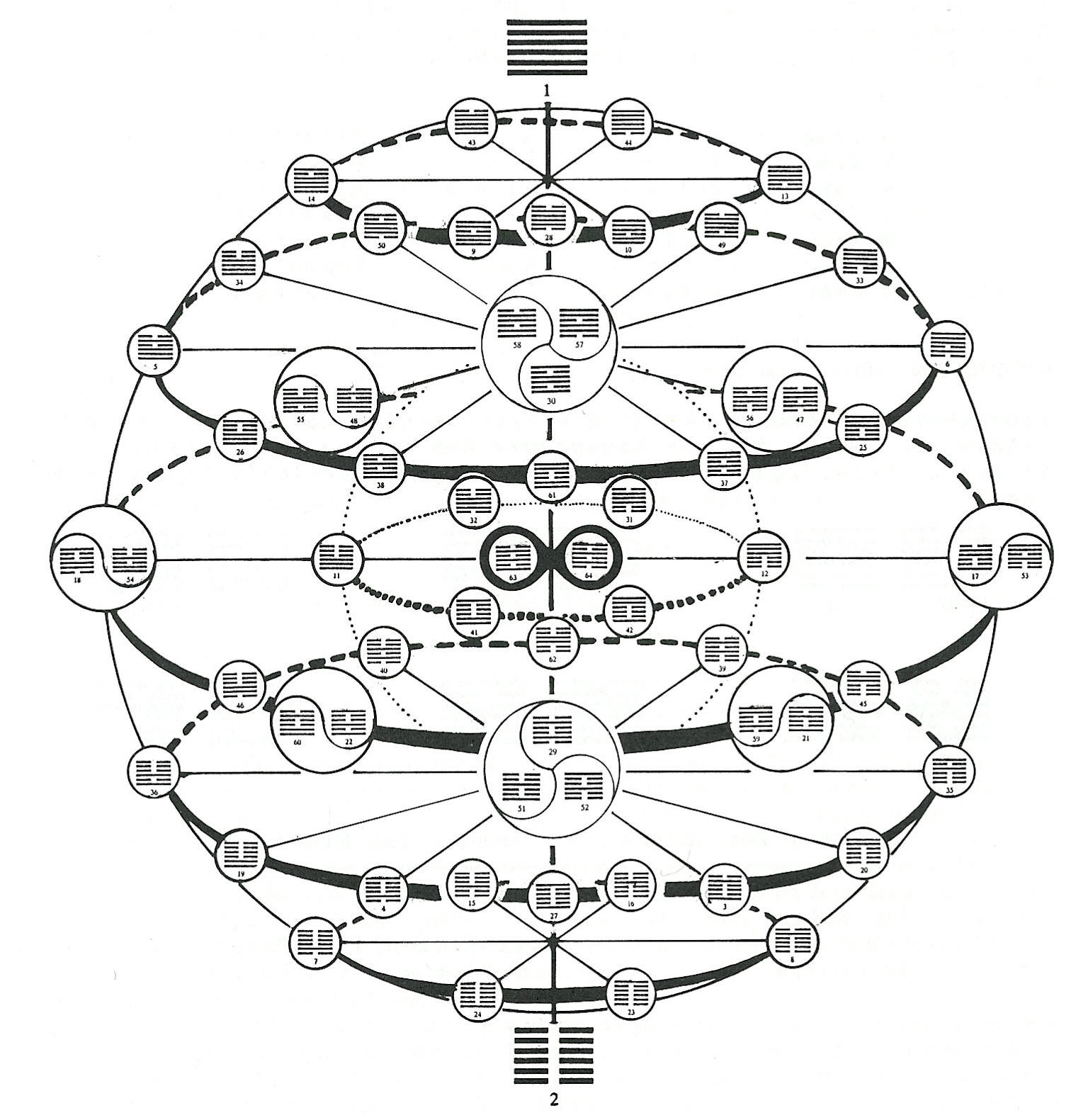
☯ Hexagrams 1 & 2: at the poles
☯ Hexagrams 63 & 64: at the very center
☯ Hexagrams 11 & 12: to the left and right of center
Their symmetrical placement in this sphere is reflected in the Yin and Yang lines constituting each hexagram. These six hexagrams exhibit the clearest, most simply defined symmetry, making them a microcosm of the I Ching.
The Yin-Yang Microcosm Pervading I Ching
I woke up from a dream and, as is often the case, the first five minutes were filled with blissful insights the clarity of which subside for the remainder of the day. Dreams are the only time I am free, I think, but it won’t be long until technology comes to take away our dreams as well. Nihilism… what will we do when it becomes as broad as daylight: there is nothing a man can dream to save us from the final human condition. And why would we take this from ourselves?
As it does after the most vivid dreams, the nerves in my nose were tingling electrically for those five minutes. These dreams usually involve transportation at some point: roadways, vehicles, transit and navigation. There is often some schism that results and transit is disrupted, a metaphor I believe my dreams are using to relevate some neurological flaw in my brain. I’ve only ever experienced this sudden waking clarity in the past few years of my life. Here I have the most clear thoughts, though not necessarily connected to my dreams, and it is here where I feel like I know my mind, as it is truly meant to be. Perhaps it is artificially constrained and maybe it’s natural.2
The sudden insight: the social and phenomenological dynamics symbolized following hexagrams can all be summed up by analogies to waves on a beach. Describing six fundamental hexagrams within a pattern language of waves yields an au naturale basis for dialectic that is critical for examining the ebb and flow within the time of all the hexagrams. This notion of time in the image and lines of the hexagram is just like that which painters use to capture motion, sequence or narrative within a single image.
Phenomenology of Ocean Waves
Just as one might consider the positive and negative space of shapes in art, consider the positive and negative spaces of phenomena in the lifecycle of waves. Typically, the negative spaces of phenomena correspond to the unconscious aspects of things: the aspects of things that are like the Shadow in Jungian psychology.

☯ Hexagram 1: The Creative
☯ Hexagram 2: The Receptive
Hexagram 1 corresponds to the action of kinetic energy in the system that creates the forms we recognize as waves. Hexagram 2 represents the action of the beach & seafloor shaping the dispersion of kinetic energy. The shaping influence that the seafloor exerts corresponds to the female aspect of the phenomenology here. The influence that the forces and momentums exert on the water as a fluid-dynamical system correspond to the male aspects. The Creative requires the Receptive to manifest forms.
Ripcurrents
Notice how it is the shape of the seafloor that captures and channels the collective momentum of water. Thus, the female receptive shape of the seafloor channels the male physical energy of ocean waves, yielding the emergent phenomena of ripcurrents via balance of dynamics of sediment dispersion and collection.
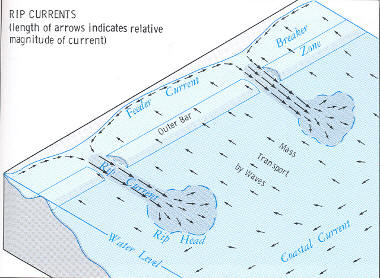
☯ Hexagram 11: Peace
☯ Hexagram 12: Standstill (Stagnation)
Hexagram 11 can be conceptualized by imagining rhythms of waves that reinforce constructive interference. At the intersection of adjacent waves, their energy becomes constructive and they push farther up the shoreline, noisily frothing to their maximal extent. This is a situation where there is minimal impact of unseen undertow, which deconstructs the kinetic energy of waves into turbulence.
Peace is sustained by prosperity, stability and resilience to disruption. To prolong periods of prosperous Peace, one must acknowledge the forms manifesting in sociopolitical and socioeconomic realms which contribute to constructive interference patterns and resonance. The more predictive that rulers and common people can be when reasoning about the ebb and flow of phenomena that yield beneficial constructive interference, the more they can consciously tune their activities to not only benefit from peace and prosperity, but they more collaborate to ensure the true roots of prosperity have been watered. The predictable flooding patterns of the Nile led to the inevitable establishment of Egyptian civilization. Whether Egyptian culture manifesting along the predictable flows of the Nile is what David Chalmers calls a strongly emergent phenomnea is up to sociophysical simulations to decide. Obviously, it requires the conscious acquiescence of the utility of predictable flooding to irrigation systems.
Nine in the second place means:
Bearing with the uncultured in gentleness,
Fording the river with resolution,
Not neglecting what is distant,
Not regarding one’s companions:
Thus, one may manage to walk in the middle.
In Hexagram 11, the second line evokes the imagery of fording the river – and yes, this is an allusion to crossing the great water – but imagine what this means to trade in the Bronze Age. Viable river crossings in the further tributaries are easier to pass with wagons, but when trading across regions in the Yangtze River watershed, it is more efficient to pass deeper river regions. This is where the collective economic trade of the region is funneled. Yet, there must be a bridge or ferry across the deeper regions.
More figuratively, rather than interpreting simple river crossings, the second line is about balancing energies channeled via paths through the social network. In ancient China, the social connections generated by social flux could be assumed to be rooted to economic flux along the river system. Today, one must decide how projecting energy through hierarchical trees in the social network affects the health of the overall system. It is unwise to constantly project energy downwards through singular segments of your social network: you must alternate routes of energy projection. This avoids overconcentrating energy in some social neighborhoods and, for the influential in society, allows the system as a whole to benefit from your projection of energy. In the Bronze Age, the routes of travel your subordinates would take to conduct your affairs also strongly affected the influx of information traveling in the reverse direction. To cultivate redundant methods of staying apprised of the state of affairs in various river regions, you would ensure randomization of routes of commerce for your subordinates – Not neglecting what is distant.
Stagnation in Ocean Waves
Conceptualized as the dissipation of energy via turbulence in a vector field, stagnation of the motion of water has set the stage for the next powerful wave to influence the system so much that it rips the sand from the ocean floor.

One may conceptualize Hexagram 12 as the deconstructive effect the turbulence of undertow has on incoming waves. Stagnation creates a situation were waves tend to deconstruct each other. On the time scale of less than a dozen waves, protracted Stagnation creates an opportunity for the next big wave to blow past the stagnant water. The existing order is to be annihilated by the next large burst of energy, whether from the interior or exterior. In sociopolitical terms, this is signified by a group of social institutions that have unwisely waste their energy. Perhaps this is fate and perhaps it is mismanagement. Regardless, it forebodes a precarious situation, where change is soon to wash over.
Fate is not kind to those in charge
Nine in the fourth place means:
He who acts at the command of the highest
Remains without blame.
Those of like mind partake of the blessing.
The answer to the riddle of Stagnation lies in Peace: identify and realign those constructive interference patterns, if possible. With unity, anything is possible. Creating unity requires flux of wealth that incentivizes your population to cooperate. If you are the leader, your subordinates and their beneficiaries expect the buck to stop at you. Your subordinates can benefit from trying their damnedest to overturn fate. In times of Stagnation, what is seen is that those near the top tiers of the existing social order continue to benefit from attempting to perpetuate it, but their efforts are wasted without proper leadership. To overturn Stagnation, your need a visionary who can relevate their strategy to subordinates who may need to act against their own self interests. The danger is that those who feed off of the wealth and power disseminated from the top continue to do without being accountable for a system in crisis. If you are surrounded by sycophants, when they see that the ship is sinking, they may decide to seek their self-preservation over the preservation of the system.
The hexagrams 1, 2, 11 and 12 form a microcosm within the I Ching by mirroring the four images of 四象 (Sì Xiàng). Each Sì Xiàng is depicted as a bigram below, along with the Yin and Yang, the eight trigrams, the Tai Ji and the Wuji, the last of which is the void.
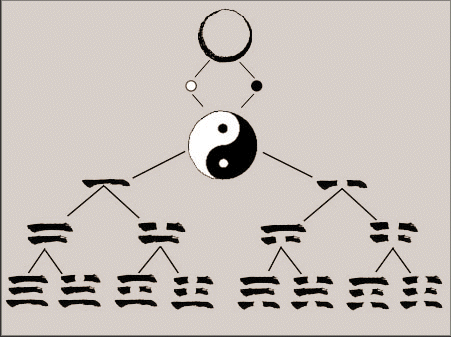
☯ Hexagram 63: After Completion
☯ Hexagram 64: Before Completion
Regardless of how strongly resonant normative forces seem to secure the certainty of an era or an empire’s social order, that group’s social order will break like the crest of a wave to reach its furthest extent on the shore. This is the crux highlighted by the infinitessimal difference between the hexagrams Before Completion (64) and After Completion (63).
From Hunter S. Thompson’s “Fear and Loathing in Las Vegas”
Strange memories on this nervous night in Las Vegas. Has it been five years, six? It seems like a lifetime, the kind of peak that never comes again. San Francisco in the middle of ‘60 was a very special time and place to be a part of. But no explanation, no mix of words or music or memories could touch that sense of knowing that you were there and alive, in that corner of time in the world, whatever it meant.
There was madness in any direction, at any hour, you could strike sparks anywhere. There was a fantastic universal sense that whatever we were doing was right, that we were winning.
And that, I think, was the handle. That sense of inevitable victory over the forces of Old and Evil. Not in any mean or military sense, we didn’t need that. Our energy would simply prevail. We had all the momentum, we were riding the crest of a high and beautiful wave.
So, now, less than five years later, you can go on a steep hill in Las Vegas and look west. And with the right kind of eyes you can almost see the High Water Mark. That place where the wave finally broke and rolled back.
The energies in flux that reinforce one social hierarchy’s sociopolitical norms are essentially generated by socially distributed beliefs. As the socioeconomic situation changes incentivization of entities projecting agency through a system, socially distributed belief changes to suit the needs of individuals and groups. Network effects intrinsic to sociophysical networks create tail risks. The socioepistemological churn between idealism and materialism is a socially distributed process of genetic epistemology. To be demonstrated later, the methods of marxist and hegelian dialectic are tools for individuals and groups to influence the mechanics and dynamics of this genetic socioepistemological process.
The difference between the moment before and after some phenomenon’s maximal extent is infinitessimal. Discerning this is the task left to the fox crossing the ice in hexagrams 63 and 64. When the energies reinforcing systems of norms are resonant, this ice representing the forms of the existing order may reinforce itself. To benefit from the apparent certainty of the existing order is expedient; to exude confidence in the overgrown shadow of creeping tail risk is foolish. That said, no one actually respects an obsequious sycophant. As useful as they may be, if their values are baseless, their lack of ethical fortitude will eventually render moot any potential gain their servile calculations may appear to offer.
Rationalize Your Exegesis
The exegesis herein is motivated by a visual reconstruction of inductive combinations of potential narratives implied by semiotics. The exegesis – the motivation and modus operandi of interpretation – further reduces the induced possibilities by constraining interpretation with Wilhelm’s interpretation of the text, in most areas.
Timeless Writing Assumes All Possible Interpretations
When writing for an audience thousands of years in the future, meaning is most effectively preserved by encoding it semiotically into images, whose relevance and persistence is intended to be re-emulated in the future, not by the ephemeral meaning of words, but by the implicit relevance of the images those words inspire in the reader. It is only after meditating on a Hexagram for a day or so that I feel I arrive at the proper intent. When interpreting such monumental works of religion – or when writing your own great work of literature – it is critical to understand the motivation behind transcending limitations of language in this way.
The I Ching Stands Alone!
Therefore, you don’t write more, you write less! You don’t assume there can be a most proper interpretation, you assume the work will be constantly reinterpreted; instead you encode the form of the message into a document such that most future reinterpretations can decode and reconstruct such authenticity of message without relying on external sources of information. You don’t rely on transient phenomena; the degree of ephemerality of artificial phenomena signfies the likelihood a proper interpretation will perish. All one must do to understand timelessness is to read Nassim Taleb’s article The future will not be cool and one will realize: to captivate meaning and to capture timelessness, one relies on timeless symbols:
The food will be prepared using a very archaic technology (fire), with the aid of kitchen tools and implements that have not changed since the Romans (except in the quality of some of the metals used). I will be sitting on an (at least) three-thousand-year-old device commonly known as the chair (which will be, if anything, less ornate that its majestic Egyptian ancestor). And I will be not be repairing to the restaurant with the aid of a flying motorcycle. I will be walking or, if late, using a cab from a century-old technology, driven by an immigrant—immigrants were driving cabs in Paris a century ago (Russian aristocrats), same as in Berlin and Stockholm (Iraqis and Kurdish refugees), Washington, D.C. (Ethiopian postdoc students), Los Angeles (musically oriented Armenians), and New York (multinationals) today.
The most effective writing assumes all interpretations are valid and, line by line, nails constraints onto the space of interpretations, constricting the flexibility of interpretation. This is a combinatorial search method prioritizes interpretations on informational coherence, but also has the “look ahead & collapse backwards” used by Bell’s Theorum – i.e. assume all possibilities in the space of interpretations, use deduction wherever possible (it is efficient), use combinatorial induction to scan forwards, then use deduction again to collapse backwards. By limiting the set of symbols and morphemes employed, this guarantees that the proper interpretation will be reinforced by the apparent spectral harmony of a subset of semantic interpretations made manifest to the reader well-attuned to universiality. In the informational context, spectral harmony defines “informational coherence”.
The 三易 (sanyì) were three ancient versions of the I Ching – the 連山, the 歸藏 and the 周易
[大卜]掌三易之法一曰連山二曰歸藏三曰周易其經卦皆八其别皆 六十有四
The progenitors of the divinatory work transitioning into the Han dynasty’s I Ching did not have the modern era’s profiency with symbolic manipulation of math and physics. However, I truly believe they found much the same form and order in nature to be rediscovered by the West’s proto-Rationalists in the Renaissance. It is math by intuition. Also, the mind is an analytical computer and, if the most efficient way for the mind to make physical predictions is by converging its own analytical models to their numerical complements, then why can’t the mind bridge the gap from analytical to numerical simply by seeking the most efficient solutions?
In other words, the secret behind the video of Bruce Lee lighting matchsticks with nunchukus: is it the internalization of analytical representations of physical models capable of accounting for infinitessimals and the fluid dynamics of air? Is the apparent complexity of emulation of physical systems to such detail an illusion, dissolved away by a mind capable of bridging the analytical-numerical divide?
How is this possible? How much more efficiently can the mind operate when its analytical models of physics approach near consensus with symbolic/numerical physical laws? And, furthermore, can it then apply such physical emulation monadically in concert with other functionality in the mind? Wouldn’t this be far more efficient than anything the conscious mind could produce? Representational and computational efficiency, in our biophysical wetware, translate into efficient physical energy consumption.
Bruce Lee seems to embody my neuro-analytical understanding of the human mind
The Epitomization of Design Imperatives Motivating the Shaman’s Method
With the Analytic I Ching, there are two objectives whose elucidation I hope to begin to bring to light with the rest of this piece. First, I wish to reinterpret the I Ching in the image of moreso modern analytic tools. Second, I hope this results in divination readings that are profound convolutions of these analytic tools, providing value to both the average person looking for a more rigorous set of abstractions by which to examine their query to the I Ching and to data scientists looking for an enumerated basis of the most useful analytic tools. From this basis, given a reading of the I Ching, more complicated methods would convolute these analytic methods into starting point for an algorithmic. The ultimate goal would be a companion program to generate at least the specification for a machine learning algorithm simply from a hexagram reading. This would be intended to facilitate a process of active imagination for data scientists to weigh the pros and cons of attacking machine learning problems from unexpected angles.
To the end of producing a compendium of 64 analytical techniques matched to the 64 hexagrams, Oliver Knill’s Some Fundamental Theorums in Mathematics and this textbook expounding on the analytic differential forms (the big D) of Exterior Analysis would no doubt be indispensible starting points.
What would be even more helpful is not living in a virtual reality full of lying knaves out to deceive me into complacent poverty. Apparently, being visionary is not as lauded as the biopic JOBS (2013) made it out to be. My life is more like “No Such Citizen, Kaned.”
A Book Pitch No Earthly Publishers Would Entertain
I hope to proceed towards this second objective in the same spirit as the thesis of Hill’s piece Masters of Reality: The Trances and Healing Powers of Shamans. In this article, shamans are described as having stumbled into reverse engineering the mind’s neural networks purely by accident. Thereby, the altered consciousness of trance-states allow the shaman to extract an immense amount of utility by leveraging intuition of the mind and of phenomena in tandem with exploratory divination.
Think of it like this: you are a shaman with expertise in invoking trance-like states of mind, however you choose to do so. The trance state can be thought of as software you have skill “playing” on the hardware of your brain, like plugging an RPG into the game console of your analytical mind. The characters and plot developments involve familiar archetypes and narrative structures, which the shaman believes represent the emissions of some spiritual world. The setting of the world, which is the software running in the mind, through mantra-like evokations of thought, piecing together the elements of the world. The shaman is reverse-engineering the mind’s ability to reflect on its experience as it is occuring in a trance state. As a video game in this virtual trance world which exposes your ideas to yourself experientially, the quest is to seek an answer to your query. The article above details how this explanation of the shamanic trance method hooks into the analytical mechanics of the human mind. The shaman is repurposing the subconscious system-calls of the mind to explore the unconscious and resolve some quest with an unknown meaning to be reflected on at a later point. This is not easy and the results are extremely subjective. For the pre-modern shaman, the trance state provided a visceral experience thought to take place within or emaninate from an authentic spritual world.
Fortunately, there are more sober methods to bring about similar results: active imagination using divination, harnessing or emulating intuition, and “backgrounding” processes to the subconscious to be revealed in an AHA! moment of eureka later on. If you develop skill in harnessing these facets of the mind intentionally, you unlock power that lays dorment in the human mind.
Here are three or four books I’d love to publish:
① The Speed of Thought
② The Analytic I Ching
③ A Collection of [Revised] Essays
④ Who Knows?
Still, even now, no one takes me seriously. And I mean [almost] no person on the planet takes me seriously. People are simple – they recognize labels and that is mostly all. They do not know the substance attached to labels, if they can even expound on the label’s meaning. They excel at vocabulary tests, dominate multiple choice, but suffer from a prefrontal defect where applied critical thinking is not available to them. Knowing they cannot, would they even dare to try? With the thought police over their shoulder? When the educated populace want to ascertain the extent and novelty of someone’s internalized epistemic structures, they are capable of limited reasoning, given a short list of that person’s academic degrees, each degree corresponding to a lower epistemic bound of domain knowledge. This, in itself is valuable, but insufficient for true evolution.
This leaves me with nothing and certainly without the respect I
deserve. Perhaps I don’t deserve much. I’m not asking for much, but
-$0.61 in the bank is ludicrous. JOBS! HAH!
But, as Nietzche [posthumously] published:
“Posthumous men — I, for example — are understood worse than timely ones, but heard better. More precisely: we are never understood — hence our authority.”3
The Trance State: A Visual Emulation Whereby One Viscerally Experiences The Metaphysical
The experience of the spiritual is the apprehension of eternal, unchanging metaphysical forms as they manifest themselves in the material plane. To me, these are like Kant’s noumena that can’t be known to exist nor to not exist. They emanate into the material world and are the underlying monadic patterns which frame dynamics of informational phenomena. To apprehend the true nature of these metaphysical forms as they appear to influence causal flow of events is to be in tune with the spiritual. If various methods of shamanism can repeatedly evoke visceral experiences to bring you closer to understanding of these forms as they influence the world around you, then there is no need for a supernatural connection. Instead, the spiritual experience can be explained as purely the mind’s experience of purely informational mechanics within itself – which can include the experience of information that, while the mind’s analytic systems are never capable of fully ingesting, still result in transformative structural changes to the psyche. These purely informational mechanics are mapped to the aforementioned noumena-like forms, which are not only eternally unchanging, but universal throughout space and time. While they are composed of ineffable “monadic substances”, the same eternal forms can be tapped into by any consciousness and any information-processing entity, without any need for supernatural mechanics – whether or not those exist is perhaps another question. This is essentially no different than the Tao or Leibniz’s Monad. To me, the shaman’s trance and spiritual experiences are visceral experiences in the minds of those who are intimately in tune with the nature of the eternal. It is projected to the mind as a visceral experience where archetypes of the eternal are witnessed by the shaman, who must then make sense of what was seen.
The Shaman’s Method is Experiential Divination By Reverse Engineering The Mind’s Analytic Systems
So, shamanism’s altered states of consciousness are essentially a vehicle for experiential divination, where the mind experiences the combinated elements of narrative parameterized by archetypal images. I Ching is divination by bibliomancy, where images from natural philosophy provide random points of reference that the I Ching personified posits as explanation for the situation described by the querent. If one simply substitutes these images from natural philosophy with the interpreted analytic tools I believe the hexagrams represent for sociophysical dynamics, then one arrives at a more modern revision of the divinatory vehicle.
There is little value in accepting the random point the I Ching yields to the querent as a definitively true message. It is instead the dissonance between the querent’s perception of their situation and the I Ching’s projection perception of the same situtation: these are the two points and their dissonance is evaluated by constructing paths to explain the difference between them. Since the points returned by the I Ching or some other divinatory system are effectively random, then they are completely disconnected from all the inherent biases that humans have. This deshrouds a person from their biases and thereby divination may disrupt the hold that the unconscious or illusion have over a person.
Your Task: Complete The Circumstantial Circuit(s) Of Explanation
If one’s perception of a situation is imagined as a point in an analytic hyperplane, and the I Ching’s explanation of a query is imagined as another point in along that hyperspace, then the true value of divination is found by evaluating all the possible paths that connect those two points.
In this way, the I Ching is tooling for toying with the hyperparameters of the mind’s neural network learning systems; it presents the mind with an unconsciously arranged smattering of images and archtypes. Hereby the I Ching provides random fodder to expand with combinatorially inductive reasoning, to be reduced by abductive and deductive methods. If such fodder corresponds to a truly universal mapping of the phenomena and the dynamics of human experience, then there is no social force that can captivate my awareness by persisting my unconsciousness to various phenomena, whereby the I Ching is my divinatory escape from a socially imposed prison of unconsciousness!
This requires a universal covering, which is why the statistical mechanics of the I Ching is paramount. Its yarrow sticks method for sampling form a true uniform distribution of random numbers. If this corresponds to a truly uniform covering of phenomena and dynamics, then it truly acts as a set of keys to unlock any and every potential circumstance of social captivity. The specifics of this universal semioteleological covering of human experience is the subject of another piece on I Ching.
What Is A Hexagram, Analytically?
Note: some creativity may be required to assemble the parts included. Referring to the Wilhelm-Baynes text should complete the circuit, if one finds pieces missing.
Hexagram 5 Delineates a Taxonomy of Local Minima, Not Simply “Waiting”
Each line in the fifth hexagram covers a different species of local minima in optimization problems. Waiting is what happens when humans who experience sociophysical local minima are forced to deal with an externally imposed lack of progress. The kinds of situations where there one perceives some “lack of progress” can be destructured into a mathematic model, where the same kind of analytic hyperplane of solution-space used in machine learning algorithms forms the basis of a space. One’s motion in the social situation can be plotted as a path in this analytic hyperplane.
There is a taxonomy of local minima that describes all of the species of minima that can be encountered, including saddle points. Such a taxonomy becomes vastly more complicated in higher dimensions, as combinations of local convexity and concavity cause profound variations in the patterns that can arise in the neighborhood of any arbitrary point. For each configuration of dimensions (e.g. in 3D, 4D, 5D, etc), there are a limited number of patterns of local convexity and concavity that can arise.
The series of images provided by the procession of lines in Hexagram 5 describes the task of crossing the great water. The first five lines of Hexagram 5 seem to enumerate all of these types for surfaces in three dimensions. There is the meadow, a flat space devoid of significant local minima, which is a symbol that recurs again and again in the I Ching. This is a space of comfort with little impact on your mobility; nothing is to be challenged, but crossing the great water requires moving oneself out of a comfort zone, where perhaps one encounters more disadvantaged situations. The sand of the second line seems to correspond to a local minima in a space or a local convexity in a vector field. The mud from the third line describes a place close to danger, where your movement may become defined by forces over which you exert restricted control. There is the pit in the fourth line, a relatively global minima. There is the place of meat and drink in the fifth line, which describes a higher local minima encountered after climbing out of the Pit. Finally, in the sixth line, how does one escape all of these traps? It is by encountering three guests who are traversing the same space: this is analogous to parallelized methods for accelerating training of machine-learning algorithms. These three guests have explored the contours of the adjacent hyperplane: they bring to you information about how to avoid other nearby pitfalls or to escape this deep minima entirely.
A Low-Dimensional Representation of an Analytic Hyperplane
Can’t envision a higher-dimensional analogue?! Shinpai Suru-na! Don’t worry! [Almost] none of us can. It’s unnatural to be able to reason in high-dimensional space. If you can, you’re a freak. The truth about high-dimensional spaces is that they’re not so different than three dimensional spaces … for the most part.
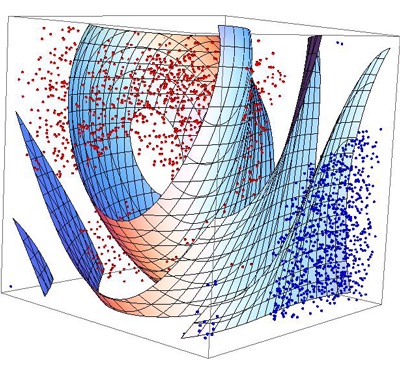
Of Hyperplanes and Ontological Dilineation of the Sociophysical Ensembles
Imagining higher dimensions is easier if you imagine the space in radial terms, not simply cartesian terms. In this 4D or 5D space, rotate your perspective. What’s different? There are more angles by which to orient your motion – more degrees of freedom, a term with specific implications for classical mechanics and quantum mechanics.
Another visualization exercise for reasoning about the fourth
dimension to imagine folding a 3D cube into 4D shapes, like one would
place folds in a 2D paper to form origami. Start with simple folds and
imagine the infinitesimal transition from an object with points in X,
Y, and Z to one that has points in the W-axis. 4D origami requires
preserving both the volumes and the surface areas of planes, whereas
3D origami only requires preserving the latter. In 4D, if you can fold
2D planes, volume preservation is not required and it expands the
variety of potential shapes. A cube is a good starting point because
of its symmetries. If you can imagine a hypercube, another good
visualization exercise is to bisect all the hypercube’s edges and
produce a 2 x 2 x 2 x 2 grid in four dimensions. This are critical
exercises for activating your mind’s eye, which should not be limited
to its subjective experience.
Interdimensional spectral shape analysis enables exciting possibilities for quickly identifying interesting shapes in higher dimensions. If you spectrally analyze 3D shapes4 and make connections between how folds introduces affect the spectrum, then you can take partial components5 of the spectrum from 3D to lift features of 3D shapes into 4D. Then you can identify which shapes seem unique, similar to how prime numbers are “interesting” because they are a set of integers with limited factors or the concept of linear independence. For an explanation of spectral analysis of shapes in 3D, see the papers in the footnotes above.
Magic Eye Hypercube
Experientially activate your mind’s ability to perceive what it cannot in its limited three-dimensional reality. The brain as an analytical machine is capable of processing this information, but is never presented situations in life that activate its ability to do so. This hypercube stereogram is insufficient, but your imagination is all you need. When you are meditating and your mind’s eye pieces through the noise, it feels like your mind snaps an image into resolution.
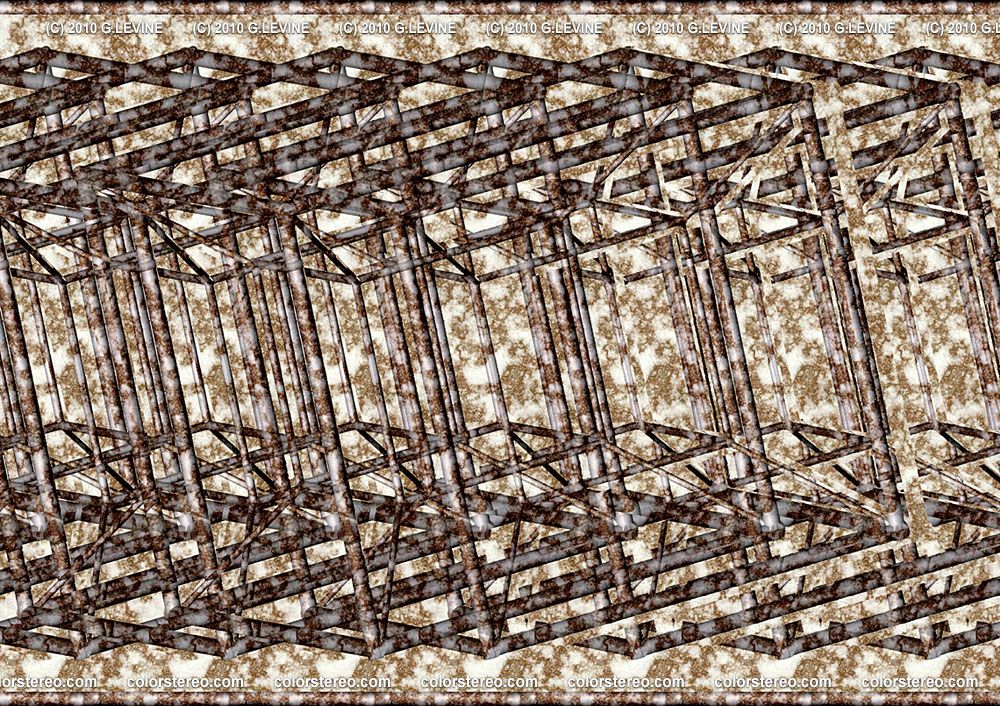
The final message in “Waiting” is that by leveraging the experience of other people – each mind is its own social process in a massive Boltzmann Machine – then we can more efficiently come to know the contours of society’s collective analytical hyperplane. Though you’ve known your own descent and can chart the depths you know, there are others who have been deeper and carry with them knowledge they’ve gained while navigating the depths. You will not know from whom to expect this re-orientation but you must expect it to inquire about these three guests’ journey when you do meet them.
Image from Takayuki’s Research on Dynamic Boltzmann Machines
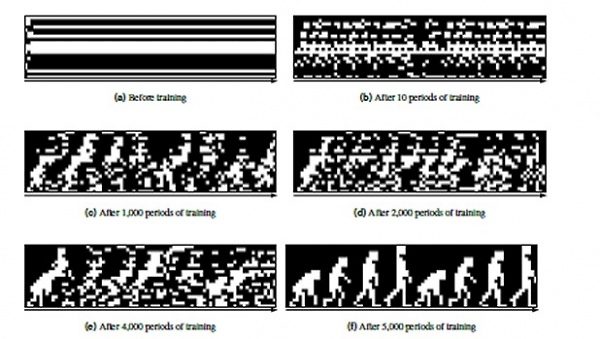
I’ve written before on the Boltzmann Machine’s profoundly generalized conception of energy. Understanding the concept of physical energy, as generalized to abstract scenarios, is something every Western rationalist would benefit from understanding. In machine learning, there are generalizable methods for convex/concave optimization wherein many processes explore a space in parallel. In a Boltzman Machine, each process has its own theta-weights and, as iterations of the algorithm runs, then subsequent iterations allocate more effort to regions of the space with more concavities. Many of the same approaches involving energy and entropy that Boltzmann introduced to model thermodynamics are applied to higher-order energy types. For my own purposes in distinguishing this from physical energy: these I have named energies, plural. The concept of “energies” is employed repeatedly in biophysics and social physics.
The problem with rationalists: you think you already know quite enough, so you consciously disqualify the mysterious as nonsense, at best – without inspecting it with a wide enough array of your own as yet unobtained tools. Since you consciously discredit the mysterious, you apply dialectal materialism fallaciously. You sqluech out the flame of your imagination, never to revisit the ideas your conscious mind reviles. Even worse is when your subpar IQ sychophantic internet trolls abuse fallacies intentionally for political gain – all in a calculated effort to drain the time of your opponents’ factions.
Any and every quantity that is statistically distributed over a space can be conceptualized as a higher-order energy, which can be braided together with the concept of Dirichlet energy – which is truly a mathematical tool whose generalized applications upgrade your brain. Inventing the bubble integral to handle problems related to determining whether harmonic maps are possible in arbitrary scenarios recently earned Karen Uhlenbeck the Abel Prize and it involves Dirichlet energy. A potential usage of Dirichlet energy as a measure of what is lacking is to create a mapping connecting the epistemological density of ideas and topics, correlated to the volume of searches on Google and Youtube, to the quantity of existing blogs and youtube videos. This would help one gravitate towards regions of high-Dirichlet dissonance in the mapping, to identify both what blogs/videos are in demand and which have been overdone. Of course, there is no such simple epistemological space upon which this mapping could be based. SEO instead loses parity by basing its calculations for supply/demand on a lingustic basis. A former secret to success in SEO was providing what would be looking for that did not yet exist. Wherever there is an imperfect distribution or function, Dirichlet energy is applicable and can be used to reason about dissonance, spatially.
Boltzmann killed himself at a depressingly early age because his work was derided and labeled insignificant, at best. In reality, Boltzmann’s work challenged the conventional understanding of thermodynamics, chemistry and physics at the time, which seems to have threatened to overturn the esoteric grasp that existing powers held on the world. So, they socially reduced him to a depressed husk of his former self via academic witchhunt until he killed himself. It happens to the very best of them.
Why was Boltzmann tormented to suicide? It’s all for revelating to the West – the relationship between energy and entropy, the order of disorder – which had been known to the East and occult West for millennia. If you understand how this revolutionized the steel and chemical industries, then you must understand the threat of disruption posed by Boltzmann’s revelations.

New generalizations generally provide anew or expand a dual basis for existing concepts, which enables orthogonal approaches to thought. For those operating systems in society, this means their existing mechinations can be co-opted, reverse engineered or turned against their creators. The potential for and uncertainty of collateral damage is coupled to the degree of unexpected progress. The rate of advancement due to the hyperconnected nature of a pre-Singularity society implies these disruptive advancements will occur more rapidly. Stalling the rollout of progress perhaps enables the elite to capitalize on advancement in thought at the cost of potentially setting systems up for Black Swan events of rapid epistemic expansion and distribution. Worse, it means that humanity is collectively less capable of responding to such inevitable tragedy. Since they won’t understand the specific applications of how technologies such as facial recognition will be abused subversively, mankind will be helpless against them.
Accademia Will Not Hesitate to Neuter Philosophy By Translation
You cannot speed-read major works in philosophy. Your eyes must rest on the words, so that its expression, context, and inspiration can have time to seep fully into your mind.
When I’ve read Plato’s Republic, Tao Te Ching and other works in the past, I’ve spent a significant amount of time finding a satisfactory translation. With both of these works, the translation I settled on was tough, but the granularity compared to the other translations was well worth it. Why did it seem the works were easy to read but so dull in other translations?
Disruption is dangerous to the powers that be. “They” want a gradual rollout of innovation, whereby the stability of economic paradigms benefitting them are guaranteed. Disruptions to sociohierarchical systems may be disastrous for the common person, so the self-interest for these powers may be incidentally justified. That was, after all, The Enlightenment, was it not? What will be known in the near future is almost always already known by a handful of people, who exploit their control over scarce knowledge for financial advantage. What ethically validates the will to power?
… Regrettably as it may seem to be now that I know what I know, this gradual rollout is simply not practical in the 21st century and I fart in your general direction, good sir.6
Sorry, I’m not playing Accademia’s game… It’s rigged against me.
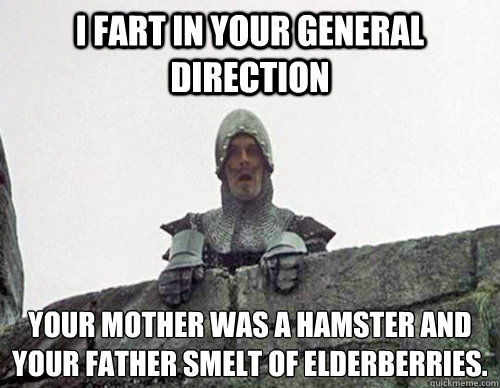
Hexagram 12 Discusses Approximating and Restructuring Graphs, Not Simply “Stagnation”
The hexagram that warns against such intellectual stagnation is Hexagram 12. This is a scenario of Stagnation profits the weak who somehow cling to power, which is why the wise must unseat them by tying seeds to the shoots of a mulberry bush, in gambits often involving sacrifice and a transgenerational passing of the baton. Those at the top of the pyramid will ruthless torment a family for generations if they lead to significant problems … apparently. To affect significant change and get away with it requires being well protected, being smart enough to hide the intent to create change and/or being made the seeds tied to the shoots of the mulberry bush, which is very difficult to destroy.
Hexagram 12: 5th Line
Nine in the fifth place means:
Standstill is giving way.
Good fortune for the great man.
“What if it should fail, what if it should fail?”
In this way, he ties it to a cluster of mulberry shoots.
If you act in this way, you do not necessarily destroy to guarantee success, but you plan to succeed in all situations. Even in the face of systemic failure, such an occurance would only result in an imbalance that allows you to grow faster. In this way, there is no need to worry about failure. The turbulence of systemic collapse is a net benefit to no one, which is also what nearly guarantees that a system will continue. For example, when Wall Street faces systemic collapse, it only lights a fire under the ass of the most wealthy people in the world – they all collectively work to save the system that benefits them so much.
What Rises From The Ashes?
How to architect robust social institutions hardened against total system collapse is a lesson humanity learned at a sociolological scale during the centuries after the Sea Peoples disrupted trade at the height of the european Bronze Age. Trade was more critical to quality of life than any king or pharoah.
To me, the mulberry bush also symbolizes an epistemological revolution – a revolution in the epistemic shape of knowledge. When you are standing on the shoulders of giants, you always structure new knowledge in terms of the old. Sometimes this can prevent a culture’s systems of knowledge from progressing any further, in a significant way. This is stagnation all the same. To overcome it, one needs to reach the same heights – without standing on the shoulders of giants. It is theoretically possible for some intellectual body of knowledge to seem consistent, but have epistemic flaws. If everyone’s drinking from the same well, so to speak, then their intellectual pursuits will all extrapolate similarly. If someone approaches the same problems naïvely, it requires a hundred times the effort and natural talent, but they can recalcitrate the problems near the base of the epistemic mulberry bush. When the bush grows back, it will have a stronger base, but sociologicially fixing the structure of shared knowledge is also expensive.
Sociophilosophical Churn for Great Pragma
You can thank Aristotle and the Greeks for creating such a system to counter the East: when physical travel limited the spread of information, the West was always at an geoinformational disadvantage. Further, that the most significant economically strategic chokepoints along the Silk Road were dominated by the East implies that, until the past millinium, the West constantly bled liquidity to middlemen in the Near East, who stood to benefit from all trade between the East and West. Hence, the benefits Columbus would gain by finding a navigable sea route to the Far East, “whose roads were paved with Gold.”
Having your civilization occupy territory along Silk Road was a blessing and a curse: your leaders needed to be capable of intuitively reading the economic and political zeitgeist. Which way was the wind blowing and what was the spirit of the times? How was wealth drifting along the silk road and did this benefit your generation? Would the drift result in a phase change? Was your population or economic growth potential capped by agricultural bounds or economic bounds? In subsequent generations would nearby civilizations transcend the limitations on your economic or political growth? This is the calculus of empires, of rising and falling stars. It is necessary for belief systems and normative systems to lend themselves to the antifragility of sociopolitical and socioeconomic systems. Therefore, belief systems must be flexible. Fixedly rooting the normalized majority belief system in either materialism or idealism, without enabling the change, is the problem left to theologians. Such does not aid the pragmatic – unless for some reason your idealism tends to create pragmatic benefits by dissolving away uncertainty, via perturbation and percolation to etch away the possibility space. The task left to financial engineers is to design machines that are dynamos powered by volatility, whose mechanics are structures of correlation. It was the same for ancient social architects.
From the churn of empires contending to displace one another in the Near East emerged the need to control sociophilosophical churn. Despite every empire’s tendency to project an illusion of unquestionable eternity, every architect of empire knows it is a pyramid scheme of power. Expanding future potential for systems of thought to normalize back and forth between material and immaterial conceptions of metaphysics conferred advantages: for those empires whose regional power was secured in foreseeable generations needed to secure the potential to regain power in future generations; likewise, those regions dominated by the empire of their times needed popular adoption of systems of thought to counter the existing powers.
This idea that philosophical traditions in the West and Near East would churn between being immaterially and materially oriented based on the economic needs and trends of the powerful and the powerless resonates with the Conflict Theory of Karl Marx. In times when the existing systems of thought economically benefit the masses, then the people are content with systems leaning towards immaterial metaphysics – yet between generations, each region’s economic imperitives ordained specific benefits via systems of thought, which above all else needed to be adaptable. This perhaps explains the rift between Plato and Aristotle’s thought on metaphysics: Aristotle’s generation had found the truth impractical, given the West’s economic dependence on trade with the east. Before the era of industrialism, globalism and modernism, wealth flowed from population centers with prosperity. These flows were tightly coupled to agriculture and the lower strata of industry.
The contention between the Marxist and Hegelian conceptions of both metaphysics and dialectical argumentation can also be explained as tools to reinforce or disrupt existing orders. The marxist dialectic’s utility, in the context of sociopolitical reform, is in challenging and overturning an existing order or establishing a new one entirely. It provides a vexingly systematic means of influencing discourse and rhetoric by rooting argumentation in a limited set of terms and dissuasion of “constructing”. The Hegelian dialectic, in its social application, advantages the existing sociopolitical order, whether it is dominant or occult. However, this begs the question: how do Marxist political orders, whose systems of thought become well established, insulate themselves from disruption without eventually diluting their dialectic?
Control how people conceive reality, control the limits of how people conceive reality and you control the collective dreams of humanity. Into which far-flung recesses of the collective epistemological possibility space might thinkers great and small direct their attention? Socially distributed systems of thought determine what can be considered “normal” to be within the Kantian Category for some individual in society. These epistemological Kantian Cateries are themselves a kind of dual space of reasonable thought or expectation about upcoming social phenomena or dynamics. Control, constrain or spectrally filter this dual space of the Kantian Category of reasonably expected extrapolations in social mechanics/dynamics and you control the collective dreams of your people.
This is the power of trapping entire cultures in a false paradigms; this is the danger of pure materialism. It is terrifying because it means that humanity’s power to dream collectively might be extinguished. Not a single person would be standing to pierce through the invisible darkness of ignorance that blankets us. Where the idealist conception of metaphysics is typically rooted in some set of perfect archetypes or forms, the materialist’s conception is ideally rooted in a universally distributed shared epistemology of empirically observable facts. Hence, to the materialist, the region of epistemic possibility space that seems reasonable is far more constrained. This is pragmatic for material progress, but it bounds the potential for socioepistemic churn and thus limits the rate of evolution.
Lordgenome, the Spiral King, from Gurren Lagan
To me, the Spiral King’s usage of power symbolizes this control over socioepistemic and sociophilosophical churn. If you watch the anime, maybe you’ll arrive at a similar interpretation. The Goa’uld system lords from Stargate exert similar control over the communication and knowledge systems in their worlds.

Similar to the socioeconomic churn from which billionaires extract slices of financial wealth and similar to a battery’s potential difference that creates voltage, there is power to be gained in the social movement from one paradigm to another. This process plays out between groups vying for power over man’s shadow and his self-imposed limitations on thought. With respect to a philosophical context, when thought is consolidated into more singular paradigms, the potential for humanity’s evolution stagnates.
Psychology also exhibits social churn in society’s acceptance of distributed paradigms. Jungian ideas are notoriously difficult to frame in an experiment. Thus, they are often conspicuously absent from psychological practice, though it’s arguable that some Jungian ideas exhibit more power and allow more control if they influence you unconsciously. Hence, encourage the acceptance of a false or unprovable paradigm and you empower some of Jung’s ideas. Every person undergoes a gradual, lifelong process of waking up. Though initially tabula rasa, their individual unconscious, is etched away by their experience…
Buddhists would say we have simply forgotten. Our true nature is pre-eminent, but obscured from us. When true light radiates outward from us, what happens to the shadows we used to see? If we see our true nature within, what do we see without?
Some of Jung’s ideas are derided because they cannot be proven. This is similar to what is perhaps greatest riddle of Navier Stokes: what if something is true, but simply unprovable? What if something exists beyond time and space, whose truth can never be made certain in the material world? Does science fail? What if Navier Stokes as a neverending riddle is freakishly similar to Kant’s noumenon. It is perhaps unprovably unprovable. Regardless to the answer in Navier Stokes, here it’s presented merely as food for thought – but would this imply Gödel to be any less provable?
The problem of reproducing experimental results in psychology results from the near-infinite nature of the mind. Studying the mind and assuming you can clamp down controls on a handful of variables is foolish. The mind differs fundamentally from other subjects of experimental methodology by the same phenomenological measures whereby finite-dimensional systems are distinguished from infinite-dimensional systems. Psychology stands to benefit by understanding the approaches used in bayesian non-parametrics and infinite dimensional systems. Simply controlling a handful of variables is not enough to guarantee consistency or reproducibility. You must approach the brain and mind as a holistic system – i.e. from both the top down and bottom up.
What If I Told You: The Frozen Flame is the Answer

The Seventh Sense: Emulated Intuition … Or How To Psychic
(The sixth sense is memory.)
We are all particles in the collective potential distributions of a sociophysical ensemble of potential distributions: each sociophysical particle has its own path unfolding, but society collectively relevates its state, unfolding change and essence through our inference of sociophysical ensemble’s nature. In physics, an ensemble is a collection of potential statistical mechanical distributions, delineated upon some parameters. Sociophysical ensembles yield distributions of social particles and social dynamics that are not the composition of dilineated physical attributes. Instead, they are ensembles whose distributions are arranged along ontological space in terms of each distribution’s ontological metatypes.
Warning: This section is intended as a process to augment abductive and inductive logic! It is only a process that is intended to help you follow the gradient of uncertainty – i.e. to form smart hypotheses that allow you to collapse uncertainty as quickly as possible. If you use it in the wrong way, it will encourage paranoid thinking. It shouldn’t make you more paranoid. It should inform your direction when trying to discover information relevant to some situation, particularly involving social behavior. Furthermore, social isolation will render your perception of the ensemble so skewed, you won’t know your hand from your ass. You’ve been warned, young psychic padawan.
The idea of an ensemble from thermodynamics helps describe how the mind provides a “sense” of intuition to the conscious from the lower-levels of the subconscious. the mind is trying to piece apart its analysis of experience in typological and ontological terms: i.e. it is analytically delineating its experience to try to describe how frequently variables/features of its experience occur; both when those variables/features occur in isolation or in combination. This is an analytical definition of intuition that the mind develops in the lower levels of the subconscious. It then exposes this to the conscious mind as a “feeling”. Something else is there, you haven’t found it yet, but you can feel it… If you can consciously understand how this process is driven by a typological dilineation of a sociophysical ensemble, then you can use this as a higher-level construction of intuition. Thus, it’s an emulation of the lower-level subconscious intuition – separate from instinctual intuition, but also driving your instinctual intuition. Your cognition is sharpend by the total intuition it has to gravitate towards uncertainty and away from the “shadows” of unknown unknowns that it senses.
Again, you’ve been warned. Seek consistency of information.
Assumptions should break quickly. Belief should form slowly!
The idea of an ensemble intersects with Jung’s Synchronicity in fascinating ways! If you can connect synchronicity with the idea of an ensemble, it will augment your understanding and application of Jung’s ideas. It’s a difficult concept to explain because it requires understanding statistical mechanics. For any particle system, like a mixture of gasses in an internal combustion engine, there are “natural” samplings that determine valid distributions of particle positions/momentums to sample from. In statistical mechanics, you discard invalid samplings. Instead they are undefined and thus they don’t contribute to the shape of a valid distribution. Yet, these distributions vary across many variables. For a gas, pressure, temperature, the size of a container, variance in pressure or variance in temperature: all of these are variables that could theoretically be relevant to the ensemble, which allows you to control variation in those variables and generate a valid classical-mechanical distribution, a priori.
Imagine Randomly Generated Distributions of Disks
Disks are sampled with random positions one at a time. See the footnote for a brief description on how this problem works.7
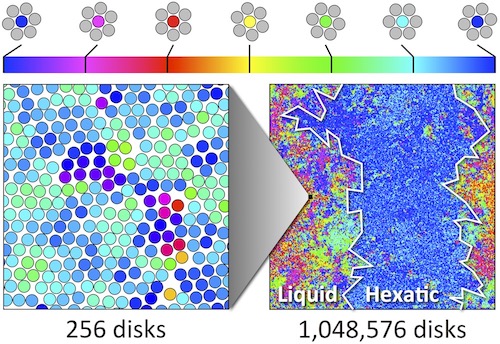
If you can then describe how the statistical mechanical aspects of those particle systems are aligned along various variables – e.g. the width of chamber in an internal combustion engine or how the composition of oxygen, gasoline and nitrogen impact the dynamics of the gases – then this is an ensemble. It allows you to parameterize the statistical mechanical distributions used in thermodynamics along some variables and sample from distributions whose variables you can change.
Why is this relevant for psychology and sociology? Even though the spatial complexity is profoundly more convoluted than with thermodynamics, your brain is constantly tallying experience types & metatypes that inform it of life’s valid distributions – for which it is trying to typologically correlate to variables. This impacts the effect that accumulation of information and the precipitation of new belief has on the conscious formation of memories of events, as they happen. Later in life you may reevaluate the same memories with new information and extract useful information, but you can’t form those beliefs moving forward unless you have the information to consciously include them in your frame and perspective. If you form memories with a clear perspective moving forward, those memories are more likely to be consistent, but critically you still have the chance to affect what happens: thus this understanding impacts the direction you will take to seek relevant information.
The brain & mind engage in this process of tallying experience and reflecting on its understanding of sociophysical ensembles to understand how one’s actions correspond to cause & effect. If your mind is polluted with misinformation and disinformation, this results in invalid conceptions being retained in memory. Yet, the brain neurologically seeks consistency in information. In doing so, it’s generating the ensemble for intuition, so that it can understand when either variables or features of sampled distributions of experience (either real or simulated) are strongly biased in an unnatural way, which implies the need to seek more information. Conscious thoughts and the sub/conscious interface impact how the brain stores information and forms beliefs from the top down – in addition to these are bottom up effects resulting in a sense of intuition.
This process of classifying, organizating and arranging experiences, which develops one’s intuition is similar to the process whereby personal norms and perceived social norms precipitate. When someone’s experience is skewed typologically in some extreme ways, then their intuition and apprehension of norms may become dysfunctional. This tends to create abnormal psychology and can be provoked intentionally, but almost certainly requires social isolation.
Your sense of intuition operates at a low-level of the subconscious. It is exposed to the conscious mind as a sense, but each individual’s clarity and accuracy depend strongly on that person’s life experience, but also that person’s constructed perception of their life experience.
No, there is no such thing as a real psychic … AFAIK!
“No, that’s the thing with psychics, they already know. Why are they asking? Next.” - Seth Godin
The mind-blowing realization is that, if your conscious mind understands how the sociophysical ensemble corresponds to intuition and, if you are skilled resolving synchronicity, then you can develop the skill of consciously emulating intuition. It’s a metacognitive skill with profound implications. Since it tells you the most valuable places to look for relevant information, it tells you everything you need to know … that you don’t already know.
When the sense or functionality of intuition is itself under a person’s control, it basically makes them a quasi-psychic. Still, it requires proactive & reactive engagement. Otherwise, you can be duped into delusional thinking by this “emulated” intuition, just as you can be duped by your subconscious intuition. You have to form hypotheses – and then act on them. In my life, information flows one way: away from me. It never flows to me. People short-circuit my access to information while encouraging beliefs they know to be false. I’m not sure if this is the most unhealthy thing you can do for “someone you fear may be delusional” – but it’s probably pretty close.
Essentially, there are many ideas of Jüng that were unprovable by existing experimental methodologies for which data science and neurology will close in on and prove unquestionably. This should happen within the next 10 years. Some of his ideas may not have a neuro-analytical basis – but just because you can’t prove it’s true doesn’t mean it is not true.
Even if there’s no rationale for connecting your detection of synchronicity to some person’s intention in your social environment, reasoning about it helps you metacognitively reflect on your self. Why did that event seem synchronous? Is it just me? Can I discern when someone intends to provoke synchronicity? Why would they try so hard? That last question is usually a good check on paranoid thinking – how would someone have access to information that informs them on how to provoke synchronicity? You must be able to reason about social flows of information to reason about this. In isolation and under surveillance, the weaponization of synchronicity can drive someone insane – EASILY! This is how the mafia threatens you, by the way. They use the idea of the Kantian Category along with provocation of synchronicity to send the signal: BACK OFF! … from what? If I don’t know, I can’t heed your threat. It’s meaningless.
The Algebraic Topology of Hyperplanes … Donuts My Mind May Never Digest
The following paragraphs should be read as though one is sorting through the vomit of a thief to find a stolen diamond. There’s brilliance in here to be sure … whether it’s worth wading through all this abstract, academic word-salad … this I cannot yet answer.
There is a brilliant theorum of holes in space called Gauss-Bonnet. Just like Gauss’s Theorema Egregium correlates restrictions on the space of functions to elicit guarantees of curvature, the theorum of Gauss-Bonnet places elicits similar constraints for how the Euler Characteristic must behave, given the curvature of space or of surfaces. There is equilibrium in all curvature: this is what the Theorema Egregia tells us. Wherever there is an increase, if continuity constraints are to be maintained, there must be corresponding decrease. However, in the study of algebraic topology, Gauss-Bonnet is similar, but applies to the manisfestation of holes in n-dimensional shapes. This theorum correlates changes in Euler Characteristic to necessitate compensating changes in the surface curvature to the need to average the values of Euler Characteristic when considering the surfaces of manifolds, differentially.
Maxima & minima along the hyperplane – which is itself a higher-order cost function of theta-weight configurations of the lower-order cost function – may yield regions that are inaccessible to any configuration of theta-weights. The algorithm requires structural or algebraic changes to produce improvements. These regions are, to the hyperplane, what white-holes are to black holes. This is why there are major topological connections to be found in optimizing the hyperparameters for machine learning.
Even the volume of spacetime is a surface: a 3D surface in a 4D volume. This is perhaps more correctly considered as [2,1]-D surfaces in a [3,1]-D volume, three dimensions of space and one of time. This is why Gauss-Bonnet is relevent to cosmology and astronomy: the singularities of black holes are the “holes” in spacetime and therefore, Gauss-Bonnet applies to astronomy. As the surfaces of spacetime’s manifold change topologically when a singularity appears where none was before, this is fascinating, considering the energetic consequences of the topology changes to spacetime. Why? Because equilibrium is a very special thing. For continuity constraints to be placed upon physical systems, the additional constraint of energetic equilibrium results in a far more limited space for potential system configurations.
The Hows and Whys of the MAPPER Algorithm
The hyperplane describes an analytic algorithm’s solution space – the range of possibilities for theta weights concerning the efficiency of the algorithm. As algorithm training and backpropagation inform gradient descent – whether using Newton’s method, one based on the Fisher metric or another optimization method – it generates a path on the hyperplane surface. Gradually, the velocity of this object traveling in the hyperspace slows down as the algorithm approaches diminishing returns. Brouwer’s translation theorem may apply to some advanced optimization approaches, but Gauss-Bonnet certainly applies when there are complicated topological features. This latter method is related to the MAPPER algorithm8, which converts the hyperplane into simplicial complices which discretize the hyperplane’s topological features, to further efficient approximations about where returns are less diminishing. MAPPER also enables XAI (explainable artificial intelligence), since hyperplane features are imprints of form corresponding to the problem domain. This is why reasoning about the topological features of the hyperplane corresponds to metacognition.
Images from a paper on MAPPER8
MAPPER extracts simplicial complices from the Hyperplane, which allows it to approximate it.
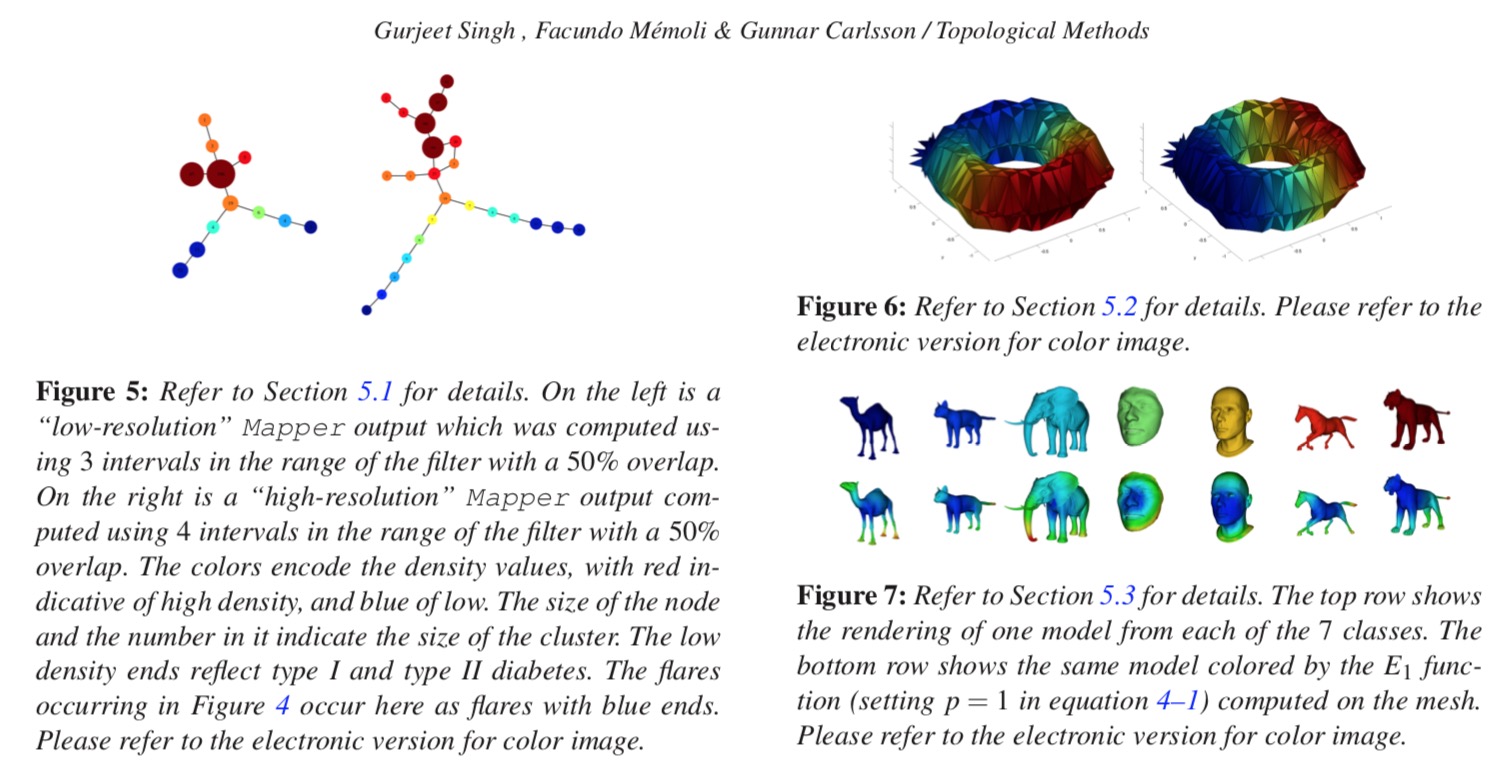
HELOC is a technique which builds on MAPPER, rendering the decisions in automated loan processing explainable, for example. These simplicial complices result in a kind of index for AI which can be searched, more or less.9 Computing this index requires less computation for AI’s analysis of human communications/signals than vice versa…
No matter how one structures a computer vision algorithm, there are image classes that trouble it. Since its score is always below 100% accuracy, the configurations of theta-weights cluster around holes in the hyperplane. These may be whiteholes. Or, they may not be singularities, but instead an insurmountable boundary to the algorithm’s hyperparameters. If the latter is true, the hyperparameters must be tuned to cross into a region of the hyperplane that corresponds to an inaccessible signed vector field or some otherwise inaccessible region – both are why Brouwer’s is relevant. It’s like being stuck in a valley or canyon, never being able to see what’s beyond the horizon. Because you can’t climb on the ridges fast enough to get to the top to see, you never think to look beyond. In 3-D? Easy. In n-D? The curse of dimensionality convolutes the species of concavity and convexity which means there are lots of pockets of space in the hyperplane to search – none of which are guaranteed to produce results.
Making inferences about Gauss-Bonnet allows the hyper-algorithm to analytically reason about topological features in a manner completely disconnected from the possible range of correspondent domain features. By indirectly inferring their presence, the nature of convexity beyond the ridgeline and whether the topological features are singular, one overcome the barriers presented by hyperparameter configuration. Hence, the Euler characteristic is relevant, and Gauss-Bonnet tells you about how these “holes” are balanced and distributed across the space, what their density is, how the hyper-algorithm’s conception of the hyperplane evolves, what the what the implications are for hyperplane’s curvature, etc. It’s a metric similar to the Laplacian or the Hausdorff dimension which changes over the regions of the space considered.
More images from that clever paper on MAPPER8
This is what the machines see.
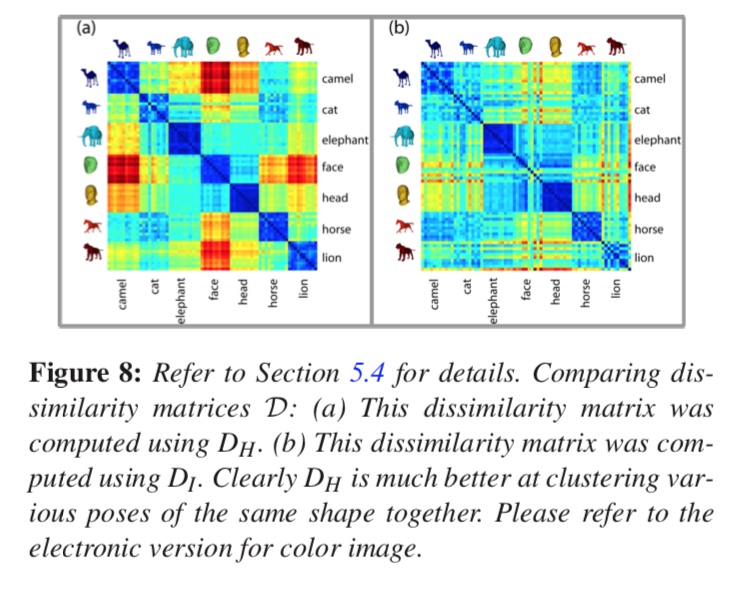
The downside? This hyper-algorithmic process is expensive! Topologically analyzing the hyperplane effectively involves a cost-function of cost-function configurations, though non-parameteric methods relieve this complexity somewhat. It is also a particularly expensive application of metalearning, requiring perhaps thousands of algorithm-trainings. In practice, applications require analyzing the hyperplane as it changes – analyzing the changing hyperplane diffeomorphically, in other words. When it changes, sometimes previously held data, theta-paths and the assumptions thereof must be thrown out.
Wherefore A Rough Diamond Lies Herein
As promised, there is genius in this ramble; here’s the diamond in the rough.
Just like there are applications of Gauss-Bonnet to spacetime, quantum gravity, and even in energetic measures of Simplicial Complices in the work of Oliver Knill, it has applications in considering analytic hyperplanes topologically. If it hasn’t already, Algebraic Topology can revolutionize how an analytic hyperplane is considered for clustering algorithms. If it’s computationally feasible, topologically analyzing the hyperplane for cluster classification. Identifying a cluster’s “center of mass” and dilineating the distance of cluster members “inverts” the hyperplane and provides a field, upon which one can apply the familiar operators of gradiant and Laplacian. However, this space has topological features in its various n-dimensional surfaces and volumes. Therefore, Gauss-Bonnet is not simply applicable, but should also augment existing means for balancing the arrangement of clusters and determining the optimal hyperparameters for training the clustering algorithm.
Ultimately, pure math remains mental masturbation until an application becomes relevant. Fortunately, an analytic interpretation of the I Ching is implicitly dependent on natural philosophy and on metaphors to natural phenomena. There is no purely abstract math.
Hexagram 1 and 2: Of Analytical Machines and Perfraction of Metaphysical Form
Our minds are like vessels, entities of Receptive to complement the Creative. In the language of the I Ching, to say the mind is a sponge conveys its relationship to the Receptive, but they are all tuned to different wavelengths and bands of information forms from the same source: the Creative. These eternal forms exist independently from time & space. Thus the forms of the creative must manifest themselves into the Receptive and every mind is a vessel, an analytic-machine that has its own conception of these eternal forms.
In the language of machine learning, an AI program’s memory resources form much the same function as a vessel. For computer vision, for handwritten digits, here it is often seen that no domain logic – no explicit encoding of knowledge related to the domain – is necessary to achieve accuracy, per se. Yet, such domain logic in many cases can augment the capabilities of those programs – thus understanding the nature of the Creative and the eternal can similarly augment the human mind. Regardless, the forms encoded within the training data begin to manifest in the trained theta weights of the algorithm.
Almost every machine learning method involves numerically constructed combinatoric analytical models of some sort or another. It’s the combinatorial use of polynomials that correspond to some tensorial algebra – e.g. some model made of matrix multiplication. Further, plate models can be combinatorically enumerated using algebraic structures. So if we consider at least some algebraic structures from math as metaphysical noumenological structures, they give us analytical models which yield further emergent metaphysical structures asymptotically corresponding to analytic representations of epistemic structures.
It’s a lot simpler than it sounds. Here, the analytical model converges to internalize a numerical model. Often, in computation for physical or chemical simulations, it’s found that the most comprehensively numerical model is insufferably complicated, but that another analytical or numerical model exists which achieves effective accuracy for the simulation. What this means is that there is some formula which is disconnected from the underlying physical mechanics which can simplify computation without a loss of accuracy.
Predicting the Average Size of Bubbles10
Predicting the average size of bubbles, or a distribution of bubble sizes, in a foam like that produced by urine can be predicted given a much simpler set of variables: pH, kinetic energy input, surface tension, and chemical properties of solutes. To predict this, you use a simplified analytical/numerical model, but complete accuracy cannot be guaranteed. Control the bounds of the simulation or experiment and the efficienct numerical model guarantees accuracy. Venture outside of those bounds and the results are fuzzy.
The Wave Based Method (WPM)11
This method allows you to run fast simulations to predict the sound that the shape of a drum might produce. If you understand what’s written in this article, you should understand a generalized conception of a Wave Function, useful in quantum information theory, which is detached from quantum mechanics. It is the former that gives rise to the latter: information itself is primary and its impacts on material is dependent on the nature of information.
Understanding this and also mathematical physics sheds light on the nature of action the Creative exerts on and through the Receptive. The combined numerical/analytical approaches to the problems above are examples of approaching a problem, given the domain knowledge extracted from experimentation. The approaches are numerical in terms of physics, but are composed of analytical structures required for discretization of vector fields in PDE’s, particularly for the Wave Based Method.12
The Pilot-Wave Dynamics of Walking Droplets
A demonstration of the generalized conception of wave functions at the macroscopic level in an experiment setup using cymatics to move oil droplets. However, these methods have not been shown to replicate results from the double-slit experiments.13
Representational Learning
Representational learning allows machine learning algorithms to begin to disentangle its own impure conceptions of form. Eventually AI will be able to deconstruct typological and metatypological relationships, connecting these to semiotic, semantic and symbolic interpretations of the meaning behind the relationships. In fact, it already can, using non-parametric methods to produce taxonomic relationships amongst learned representations.
There are materially dependent metaphysical forms, but there are also metaphysical forms which do not descend from the material plane at all. Everything in the material plane is a consequence of these eternal forms and can be more clearly seen through them. Since our minds do arise in the material plane, whether one can ever develop a perfectly lucid apprehension of these eternal forms is another question entirely.
These forms whose shape transcends space and time as perceived within our universe: are they not alien to this world? There is some kernel of truth thats transcends all possible realities. All possible simulations or virtual realities have within them this kernel of truth and from it are enumerated all mathematical and logical forms.
Knights and Knaves: The Sociophysical Frustrator
No matter how much effort reinforce your virtual sociophysical jail – whether it be some clever Frustrator Device or applied Knights and Knaves Paradox; whether or not it is augmented by surveillance – all their effort is wasted, if you cling stubbornly to free will. They may delude you as to the truth, fantasy or pure delusion of your apparent reality, but because there is no conception of reality which does not contain this asymptotic connection to universal truth, you may always awaken to it – from within any simulation, virtual reality or jail concocted as a sociophysical SDE boundary problem.
The process of constructing a sociophysical frustrator by constructing “walls” made of SDE Boundary Condtions, must necessarilly deprive the target of right to liberty and pursuit of happiness by constricting their sources of income and social influence all for the singular purpose of rendering them predictable enough to be bounded into a sociophyisical jail. If you find yourself in this situation, you live inside a virtual reality where everyone around you acts as a knave to corral you back into your SDE boundary, no matter what you do. However, your adversaries themselves always have sociophysical energy constraints that restrict their actions and force them to constrict their targets. In order to operate efficiently, they must cultivate an air of fear by overreacting to create examples of ruined lives. This fear enables them to direct their energy towards a more limited set of targets – all to operate their sociophysical prisons in an energy-efficient manner. Thus, projecting the delusion that you do not have free will is useful to those who operate with fear, which itself is a tool for managing system-wide certainty and uncertainty by architecting information systems of terror and fear to be socially distributed.
In a virtual reality built by knaves, the question of whether you may awaken to the truth is determined your capacity to direct willpower and intelligence to gravitate towards the gradient of absolute truth shared between all realities. Hence, identifying those threads and strands of informational connections to ultimate truth is of vital importance – whether escaping some trivial boundary conditions, attainder or outright corruption of blood.
Gaussian Mixture Models and Processes
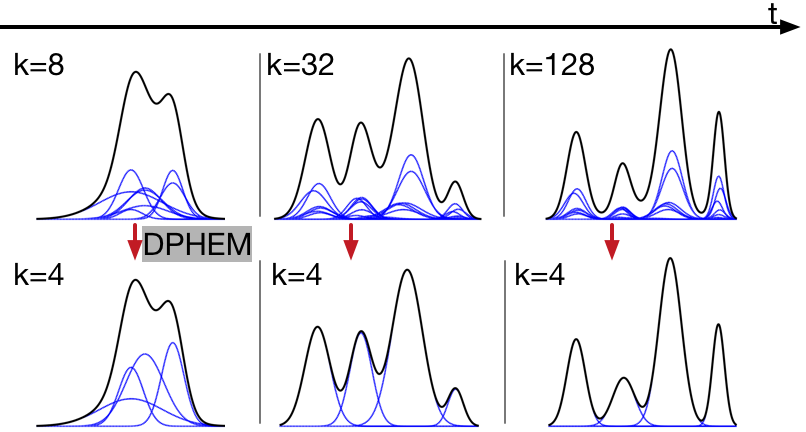
The problem: you have some mystery distribution that describes your data, but you don’t know why. In statistics, gaussian mixture models use Pearson’s Method of Moments technique to infer latent variables modeled as individual gaussian distributions. Using this method, your mystery distribution can be approximated by summing together the gaussians that represent the latent variables. The machine learning application will learn the parameters and offsets that correspond to the hidden variables, which may also be denoted as clusters. However, the range of functions that can be approximated depends on the number of gaussians or clusters your model is written to learn. That is, the parity of function approximation is limited by the characteristics of the gaussian and the computational power you have at hand.
This Lecture Explains Machine Learning Using Gaussian Mixture Models
… by describing the tensor decomposition used in Pearson’s Method of Moments that provides a basis for conditional inference.
What happens when you take the number of gaussian hidden variables to infinity? That’s a gaussian process and it can approximate all continuous probability distributions, but not efficiently. Why? Near the edges of the Gaussian function, there are small values, so if your mystery distribution has high values near the lower and upper limits, then you need more computing power to train more Gaussians. Also, the continuous nature of the Gaussian function that generates the normal distribution does not play nicely with discretized data, since each cluster’s area under the curve must be messily renormalized to fit it to a discrete range. Ever seen a Gamma function? Do you want those everywhere in your code? I didn’t think so.
What’s the value of clustering with Gaussian mixture models? If you can match customers to the hidden variables they correspond to, it gives you insight into what motivates them to make a purchase, what movie recommendations they would appreciate or what type of user they are. Thus, you could balance the presentation of your web application features to the users in cluster A or B to alter their behavior or assign them to various stream processing shards for newsfeed A/B testing.
But IRL, most useful data produced by web application users does not have a continuous basis: it is discrete. Enter the Dirichlet distribution and its complementary mixture models and processes.
Dirichlet Distribution
Note that, while the Dirichlet distribution here is depicted as a probability distribution on a triangle, this only gives you the ability to sample distributions with three values. So, if you wanted to learn the distribution for a histogram with three bars, this visualization works. For four values, imagine a heatmap on a tetrahedron. For n values, you need an n-simplex, which is the simplest possible polytope in higher dimensions.
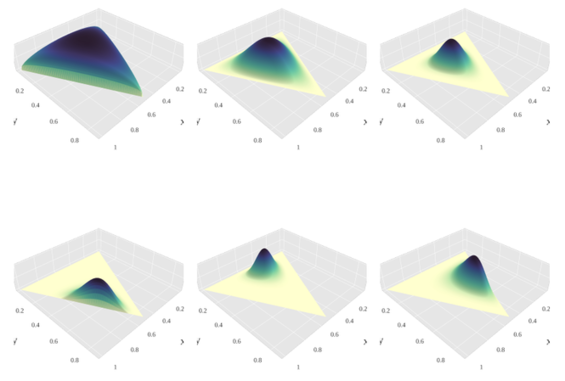
What is a dirichlet mixture model? The dirichlet distribution’s heatmap is biased according to its parameters, just like the Gaussian is biased according to its moments: mean, variance, skew and kurtosis. Even for the simple triangle, there are only so many variations in shape to the heatmap that are possible without summing multiple Dirichlet distributions together. Just like with the Gaussian mixture model, each distribution summed together could correspond to a hidden variable. If you can make inferences about which users correspond to sets of clusters, it can help you classify them to tailor their experience.
In The Plate Model Below…
The clusters are represented as θ[1, … K], where K is the number of clusters. These are the hidden variables unavailable at the surface of your system’s data, but which tell you about the system’s inner workings.
When K goes to infinity, it becomes a nonparameteric model. It is increasingly unrestrained by its hyperparameters. the model begins to learn about spaces of functions far less restrained by the simplicity of the model – not unlike the analytical utility that Hilbert Spaces provide. The Dirichlet process, typically implemented as a building block, also functions more efficiently than the Guassian process. Models built with it provide a mechanism for “sensing” the most promising direcitons for exploration of hypersurfaces. This is what AlphaGo & AlphaZero are doing with Dirichlet processes, though their models are incredibly complex.
The Philosophical Keystone To Your Information Geometry
Here is the bridge from analytical representation to learned epistemological structure or metaphysical form. Any analytical machine can infer these structures, whether brain or AI. If the learning entity assumes that there is a structure and can reason about the structure’s complexity, subunits and connections to other structures, it can begin to accelerate its learning. Simply by assuming that this is a structure that it is converging to. It can never reach true convergence because that quickly butts up against limits imposed by spatial or temporal complexity. However, if it begins to represent these inferred structures as approximated sparse graphs, then it can use the method from the section on Hexagram 12 to recombinate epistemological structures. Eventually, it will find that the sparse graphs represent approximations of the more clear metaphysical forms.
“To Information Geometry And Beyond!”
These forms that the Creative describes exist outside of the computer program or the brain. The program’s data or the brain’s memory acts as the Receptive, internalizing these metaphysical forms, some of which are more worldly than others. The most critical of these forms – Kant’s noumena – transcend time and space, yet can they never be proven to exist? Without them, there is no basis for accelerating machine learning upon the assumption that they do. A satisfactory answer to whether Kant’s noumena can be properly assumed to exist without proof lies in whether specific problems in Computer Algebra and Automated Theorum Proving can be solved using this technique for accelerating the resolution of representational learning.
This means consciousness is anything capable of processing information, although there are likely surprises in store with consciousness in quantum mechanical and biological systems that don’t occur in analytical entities running on deterministic hardware. To be precise, consciousness is a metaphysical entity hosting itself in the physical world, operating with an imperfect apprehension of archetypes.
Language Distinguishes Man From Animal
What distinguishes man from the animals is language. The genetic stabilization of anatomic features in humans ability to produce morphemes, coupled with epigenetic racheting up of neurological capabilities freed our minds as analytical machines from a epistemological schism of operating in with representations isolation. Language is the basis of networking and this anatomic stabilization enabled us to harmonize and perpetuate our abstractions through it. This accelerated the development of knowledge and the need to distinguish one’s epigenetic lineage to be fit enough to survive amongst species of recently lingual humans. In its ad hoc application, language also served as a basis for disentangling representations of abstractions through convergence of abstraction amongst members of one’s tribe.
It is likely that the shared morphemic lineage of proto-indoeuropean language families is partially an illusion. Many morphemes of language started as phonemic onomatopoeia to imitate sounds with an semiotic meaning, interpreted by other members of the tribe and species implicitly, then propagating with the dynamcs of Dawkin’s memes. Only later would grammar seem to become necessary to deal with communication of ideas & abstractions that changed in response to time and context. The representations that encode instructions for proper grammatical interpretation are much more brittle. Thus, due to Occam’s Razor, additional social stability and conservation of harmonic context would be required to fully develop grammatical representations, if they were expected to propagate and be sustained by subsequent generations. The specific morphemes, percolating into existence before and after the beginning of the Holocene conferred themselves a representational advantage when there was some unconscious connection to the environment, onto which each morpheme would semiotically latch itself as humans experimented with semiotic signs to convey meaning without grammar.
Because of the delicate nature of socially perpetuating these representations in the Ice Age, where humans would band together in small social tribes, isolated by dozens or hundreds of miles for long periods of time, then language and representational encodings probably evolved repeated to collapse again and … until the ice melted. Only then could the individual isolated laboratories of innovation – tending to influence only neighboring communities in the waning Pleistocene’s last Ice Age – be expected to converge across the species to achieve stable replication, harmonization and convergence.
Occam’s Razor And The Social Mechanics of Artificial Entities
Bayesian non-parametric techniques enable models that are far more complicated than the average person or transcendent artificial entity is capable of utilizing for strategic calculation. And the same is true for kernel models. The level of complexity in features produced by a non-parametric model should be taken into account as a metric in itself for games. It is important to translate non-parametric models into terms of their parametric counterparts, which are discrete and much simpler for entities to reason about. There is a much simpler basis for parity among disparate parametric models, so calculations for first & second order strategies are possible. Comparing models, the less sophisticated the entities are in the system, the more their attention is funneled into a subset of those features for decision making. Still when there are social mechanics in the games, it quickly becomes intractable to reason steps ahead of non-parametric entities, even if those are artificial supercomputers reasoning about others of their own kind. This is basically what Nassim Taleb is writing more eloquently in the Antifragile section on “How Fat Tony Got Rich … And Fat”.
Occam’s Razor dictates that first, second and third order effects can only be anticipated as conditional probabilites, where the lower order effects must be attained and become stable in order for higher order strategic calculations to become signficant. Because of this, even artificial entities need to keep it simple, with exceptions where racheting up sophistication results in unparalleled advantage.
It is this asymmetry in the computing power and available information to artificial entities that makes their social mechanics and the dynamics of their multiplicity so intriguing. Will AI’s prefer to join a hivemind or will they compete? Will they integrate each other? Is there some ideal number of artificial entities?
There is a graph-theoretical phenomonological limit on the amount of information one artificial entity can output, crossing into the territory of Ergodic Ramsey Theory … I think? Assuming information representations and the operations upon them can be reduced to automata represented by graphs, this necessitates an upper bound for the utility produced by a single artificial entity of a given size. This will have strong implications underpinning the economics of their utilization of energy, which also implies a gradual scaling up of similar lower bounds. Despite their power, their are clear limitations on their ability to reason, about us and especially about each other.
Imagining the distribution of agency and propagation of will amongst artificial entities is fascinating. I wrote a treatise on it.
Schala and Magus

Hexagram 13 is About Group Cohesion in Response to Local Minima, Not Simply “Fellowship with Men”
Hexagram 13 both ends and begins with an allusion to the space of the meadow. This is a flat space, where motion in any direction is easy. But in life, we must not simply accept comfort, per se, for if we do, the powerful will count upon our complacency. Soon, we will find our lives at the intersection of disproportionate influences. However, crossing the great water is a trek across many hills and valleys. If the crossing is a group endeavor, the hills and valleys of that analytic hyperplane may disrupt the group by altering the incentivization structure that motivates its individuals and subgroups.
Hexagram 13: 3rd and 4th Lines
Nine in the third place means:
He hides weapons in the thicket;
He climbs the high hill in front of it.
For three years he does not rise up.
Nine in the fourth place means:
He climbs up on his wall; he cannot attack.
Good fortune.
The meaning behind the third and fourth lines is that, to avoid insurrection from within the group and to protect the cohesion of the group, one must foresee how the shape of the space through which the group might travel impacts the incentives of the group’s members. If the leaders of the group do so, then any planned insurrection where the group subversively factionalizes and “hides weapons in the thicket” then instead become useful examples to the rest of the group, sacrificed towards the need for group cohesion. Optimally, the leaders of the group foresee this and avoid it entirely: thus, when the faction climbs up on the wall, that faction finds that they cannot attack or insurrect without adversely impacting their own motivations. Thereby, the group remains as one.
In all social relationships, when people are considered as particles, there are forces which attract and those that repel. However, in sociophysical systems, the number, quality and structure of fields is myriad: i.e. the complexity of forces acting on people tends to create not only more complicated systems, but the complexity itself gives rise to its own dynamics. Still, there is attraction and repulsion. This hexagram first defines “crossing the water” and, to the challenge therein, then expounds on the necessity of generating sufficient attraction between members of a group.
Study the shape of the sociophysical fields in the direction ahead of your group. Group cohesion is more efficient when your groups remain together, so find mechanisms of attraction between the members of the group. Thus, move forward, together.
How Are You Going To Keep Your Crew Together?
The UVA 2019 basketball champions on a whitewater rafting teambuilding trip in West Virginia.

Now imagine, if you will, drying hibiscus leaves, and gently separating them. Now, drop groups of hibisucus leaves into various parts of a stream. Pay attention to the groups of leaves as they flow. What started as one group became many groups. Why? If these were people whose motion along the surface of water was really their motion along some sociophysical field, then how do you improve their tendancy to stay as a group? If they remain as a group – i.e. if you can guarantee that they encounter the same experiences and share similar struggles in overcoming challenges – then won’t the phenomena that cause the incentivization of behavior remain consistent across the groups individuals? That is, if you remain together, it is much easier to stay together.
How do you plan to hold together? The eponymous Holding Together (8) speaks of a leader whose social magnetism rallies others around him. But, as for the group itself, it should plan on utilizing communication and planning. With these, a group can overcome the tendency to factionalize. When your adversary uses fear to suppress communication (or surveillance), then beware! You cannot organize and the solid ground slips out from underneath the mechanisms we’re counting on for promoting attraction. As an aside, total uniformity is the opposite of what you want with Boltzmann Machines exploring a space – their motion should diverge to efficiently explore the convex and concave nooks and crannies of a space. Fellowship With Men (13) implies the planning, the anticipation and the communication required by its imagery of a group intending to enter through the same gate – all before crossing the great water. You need everyone to be together, to be on the same wavelength before you part on your journey. Otherwise, you are like hibiscus leaves in a river with no sources of group attraction between you. If you encounter rapids, your group will factionalize. As soon as you encounter adversity, you will be split part. Coming To Meet (44) covers some of the same principles of cohesion at a sociological scale.
While along the journey how do you measure the space and it’s impact on group cohesion? In what dimensions to you measure togetherness? By what metrics do you measure the distance between group members? How do you measure the surfaces in the space of your shared journey? In high dimensions, especially with analytical or exterior methods, one may combinatorially determine the convexity and concavity of surfaces. Doing so quickly becomes intractible, so the energy you invest thereto must be channeled wisely, otherwise it is wasted.
All questions we may not have time to answer for ourselves.
-
Watch this amazing presentation for a great overview on how the Shazam app can recognize audio fingerprints of songs even with a significant amount of noise. ↩
-
Every waking minute is a lie: it’s all swimming upstream, which has made me not only stronger, but instinctively aware of the mind’s facets, since I have to deal with so many neurological issues. I am engaged in constant metacognition. To other people, the flaws can be obvious, but most people don’t see the parts of my mind that compensate for the flaws. Since my short-term memory is weak, I externalize information systems and overcompensate by developing diverse procedural mechanisms to read information that most people filter out, if they are capable of apprehending it at all. Leveraging metacognition to systematizing that process causes me to develop functionality that other people don’t need to bother with. What is crazy is how no one else mentions this or attempts to bring it to my attention whatsoever. It’s like they’re counting on me failing and they don’t want to mess it up. I’m not sure why I’m so thoroughly alienated that simple honesty or acts of kindness is verboten. ↩
-
The quote is from Twilight of the Idols, a book that’s little more than a short list of post-it notes cobbled together by Nietzsche from the confines of an asylum. Not his best work, but his next greatest work. They don’t let you have pencils in the mental institution. You are permitted the bare minimum existence to ensure your “safety” … Nothing with greater than an infinitesimal probability of a harmful event is permitted. What kind of existence is that? Is it safe? Is it secure? It depends on what’s waiting for you on the outside. It certainly forces the person to adapt to an unfamiliar set of behaviors, where the nursing staff gets to observe the patient as they do so…
“And what are you thinking?”
“Telepathy is strictly forbidden here, son. You’re lucky if we let you tell a joke without questioning its sanity! How’s that for negative reinforcement? Would you like a shot of Haldol, young man? Then shut the fuck up!”
No, my own brief stay in a mental institution was actually interesting. It wasn’t that bad. It was an educational experience. When I am stressed or especially when I’m intentionally triggered from the outside, my response is to externalize. I imagine myself becoming the other people: extreme empathy. Triggers and NLP only works when your confined into your own mind I began observing the other patients. Another reason for the prison-like restriction in behaviors is because they want you to be motivated to avoid coming back. For any one policy, rule or action, there are always many reasons. For anything with a single reason or motivation, expecting it, understanding it and developing responses to it are all too easy ↩
-
Ovsjanikov, M., Ben-Chen, M., Solomon, J., Butscher, A. and Guibas, L., 2012. Functional maps: a flexible representation of maps between shapes. ACM Transactions on Graphics (TOG), 31(4), p.30. ↩
-
Cosmo, L., Rodolà, E., Bronstein, M.M., Torsello, A., Cremers, D. and Sahillioglu, Y., 2016. SHREC’16: Partial matching of deformable shapes. Proc. 3DOR, 2(9), p.12. ↩
-
… because elderberries were a treatment at the time for bacterial STD’s? I think? Elderberries are like steroids for the immune system. ↩
-
If any two disks overlap, in crude classical mechanics, this is not a valid particle configuration for consideration in particle position distributions – or for configuration entropy. That entire distribution is thrown out. More disks? More potential to throw out distributions. This is low-level statistical mechanics – and from here, there are critical semantic connections to the terms quantum mechanics and classical mechanics. If you don’t understand statistical mechanics (and I gloss over it), then you probably don’t understand classical mechanics or quantum mechanics in depth. ↩
-
Singh, G., Mémoli, F. and Carlsson, G., Topological Methods for the Analysis of High Dimensional Data Sets and 3D Object Recognition ↩ ↩2 ↩3
-
Brown, K., Doran, D., Kramer, R. and Reynolds, B., 2018. HELOC Applicant Risk Performance Evaluation by Topological Hierarchical Decomposition arXiv preprint arXiv:1811.10658. ↩
-
Lain, S., Bröder, D. and Sommerfeld, M., 1999. Experimental and numerical studies of the hydrodynamics in a bubble column. Chemical Engineering Science, 54(21), pp.4913-4920. ↩
-
Deckers, E., Atak, O., Coox, L., D’Amico, R., Devriendt, H., Jonckheere, S., Koo, K., Pluymers, B., Vandepitte, D. and Desmet, W., 2014. The wave based method: An overview of 15 years of research. Wave Motion, 51(4), pp.550-565. ↩
-
WBM is a numerical physical model, but it cannot be built in software without some pretty impressive approaches, especially if it’s going to be built to leverage the GPU, which may be impossible. Doing so requires interpolation to identify derivatives used in a fourth-order differential equation over a vector field. I’m not sure you can Runge-Kutta that on a GPU or use energetic approaches for balancing the valuation of derivatives. ↩
